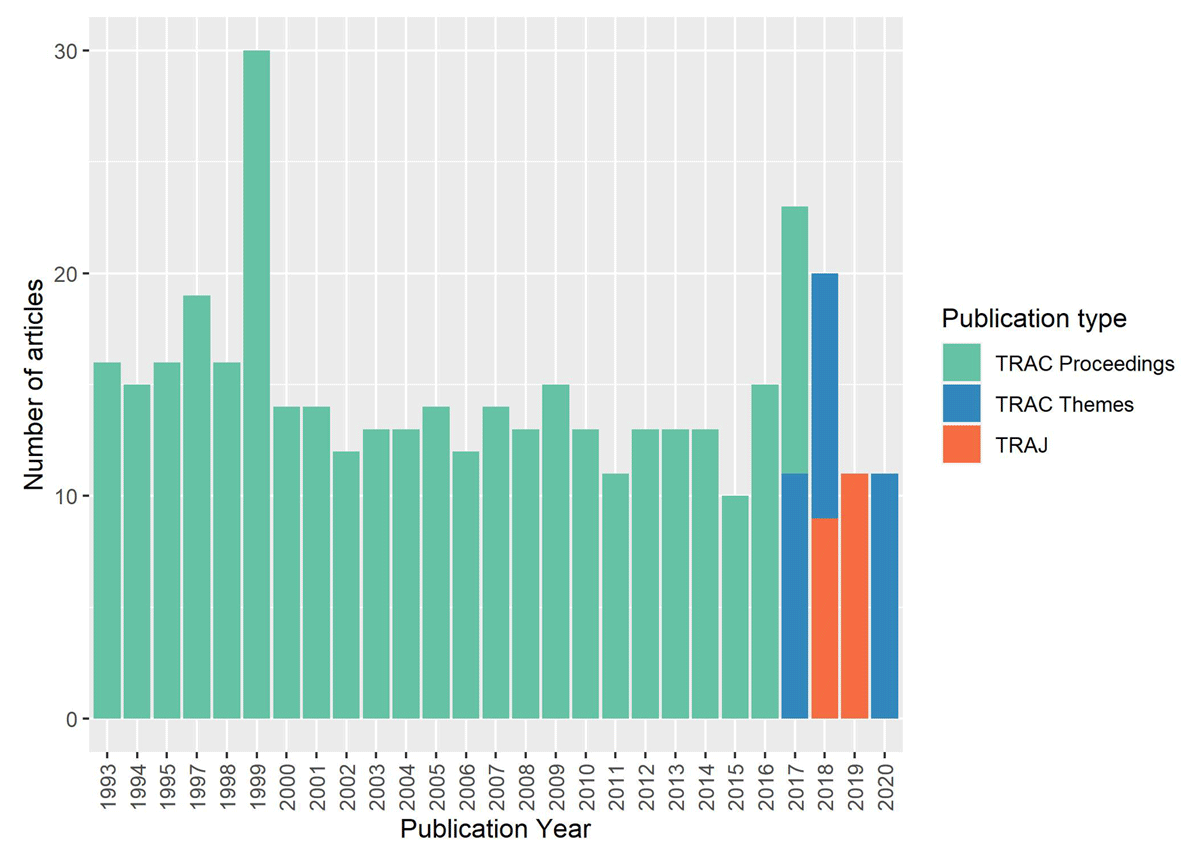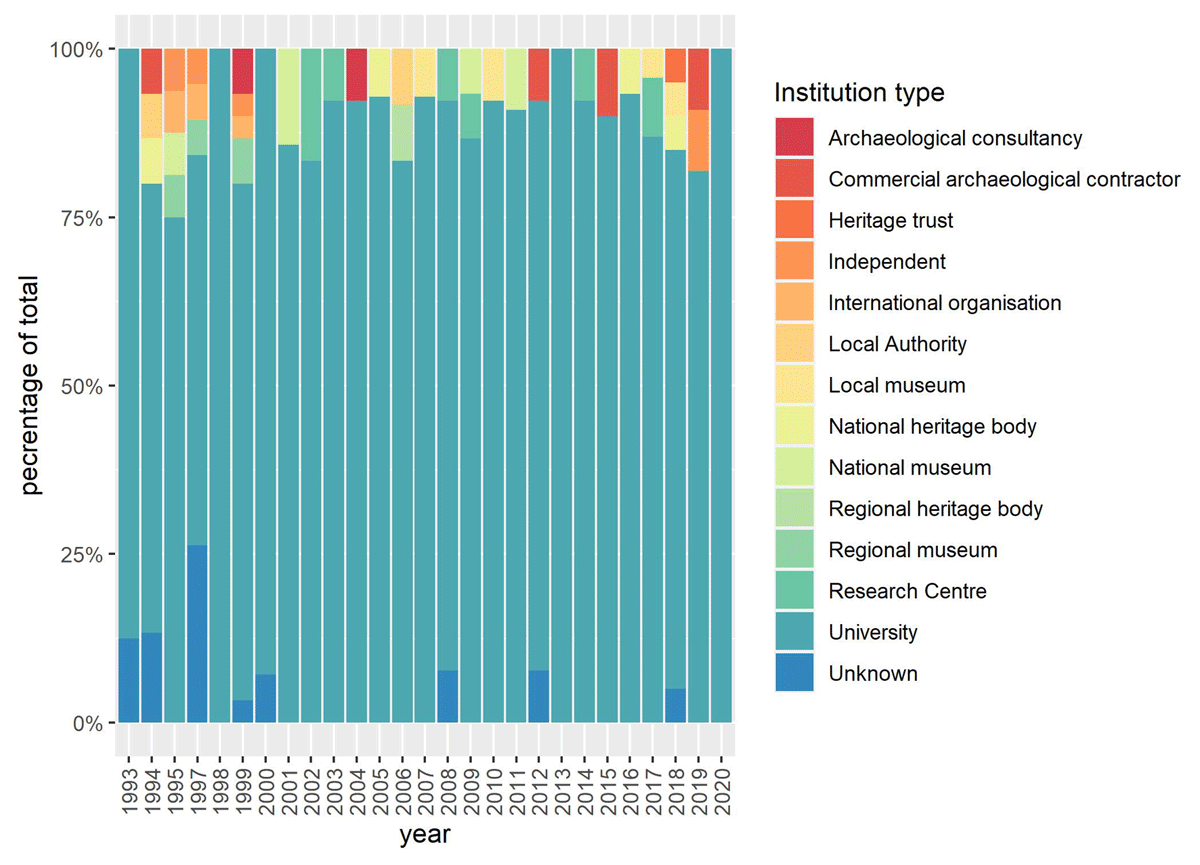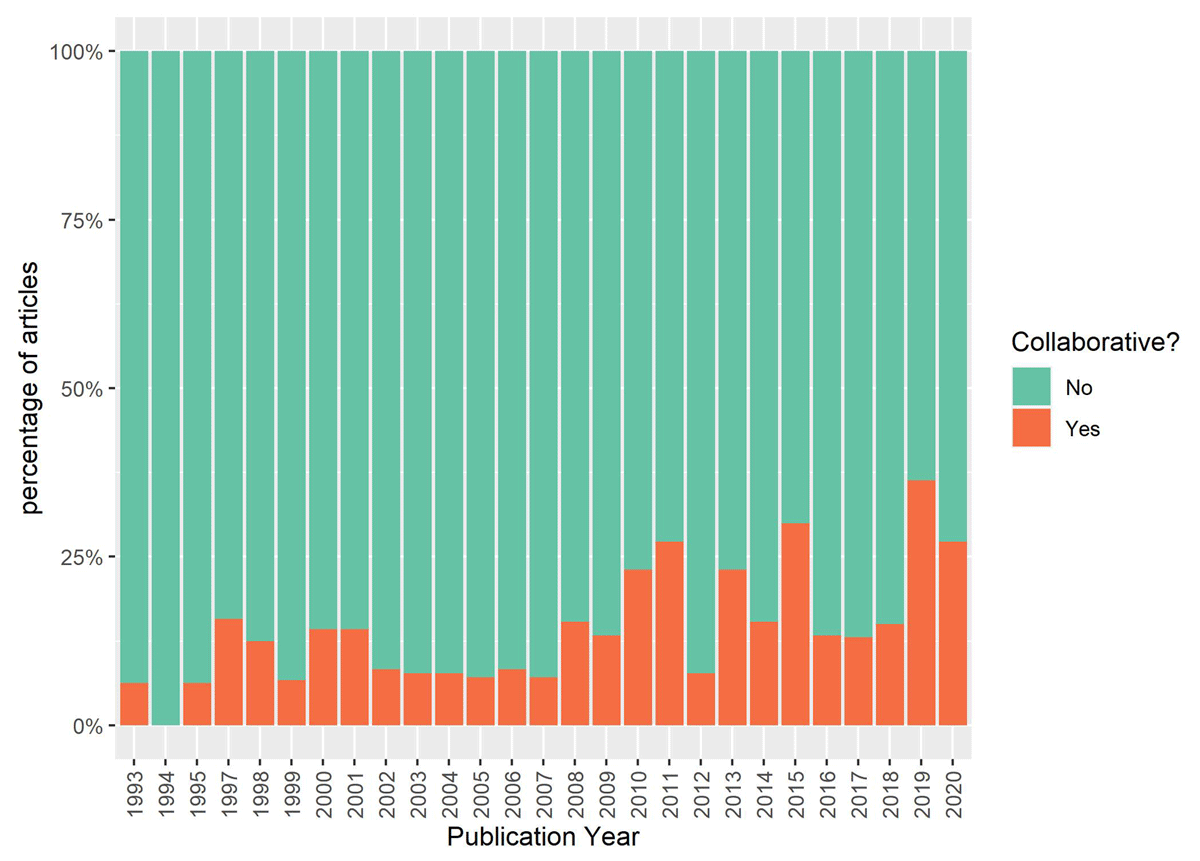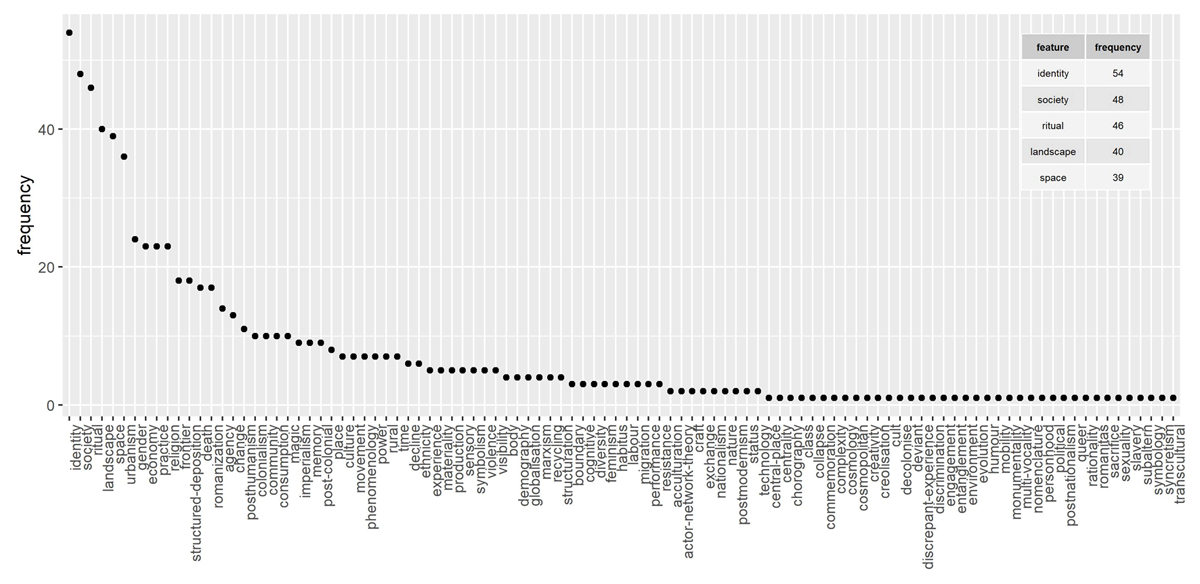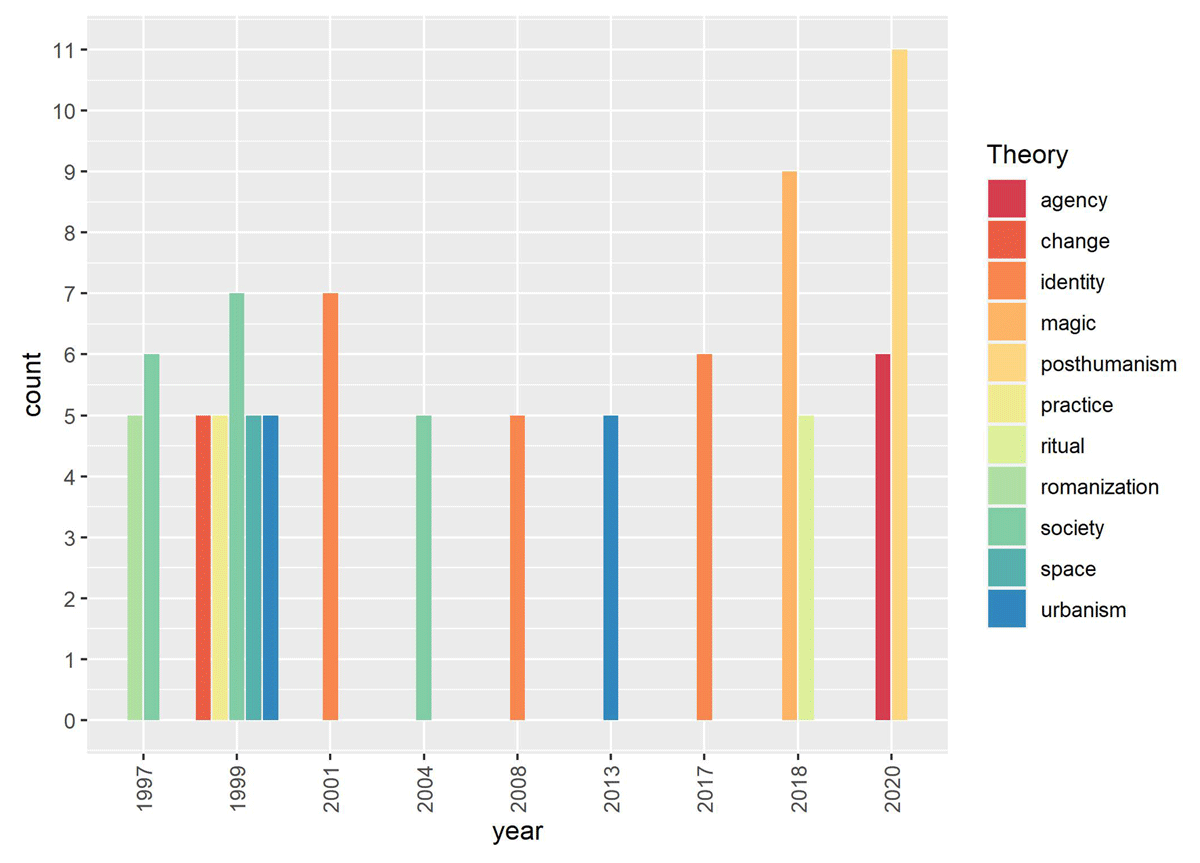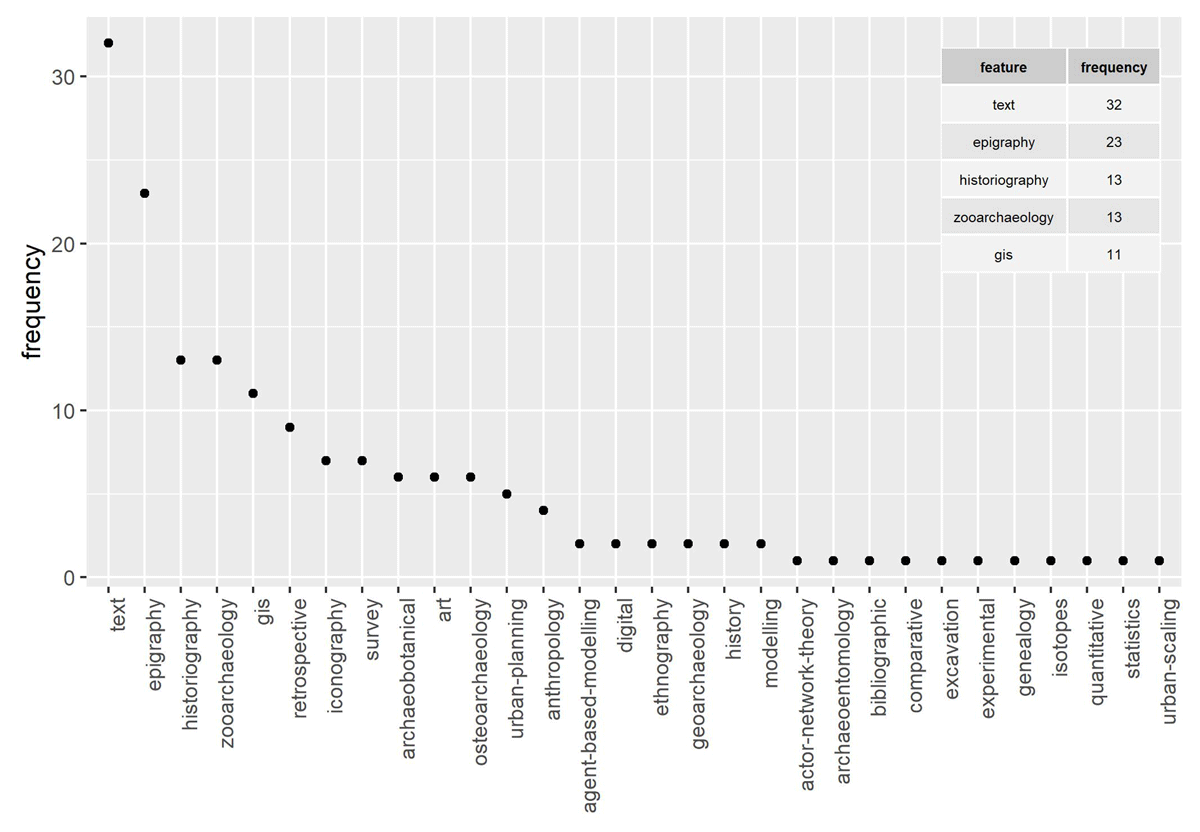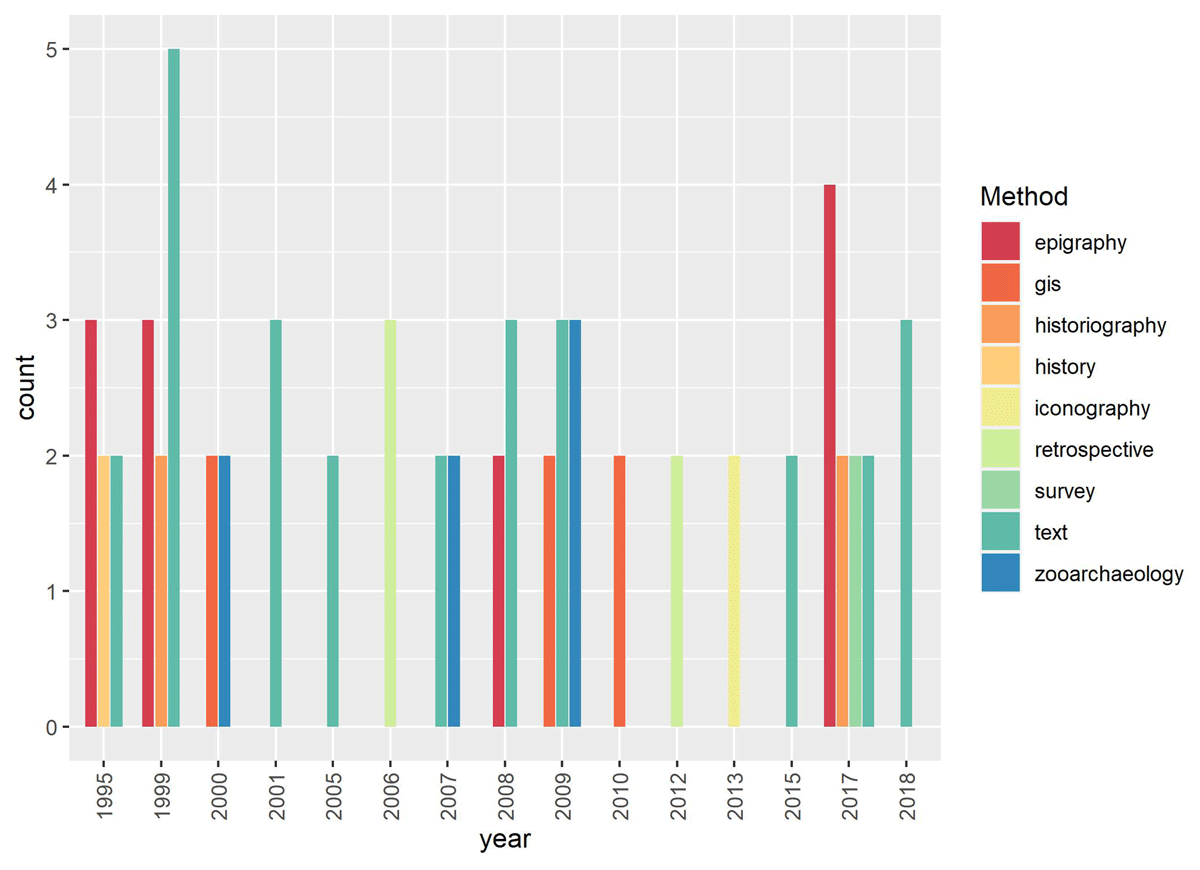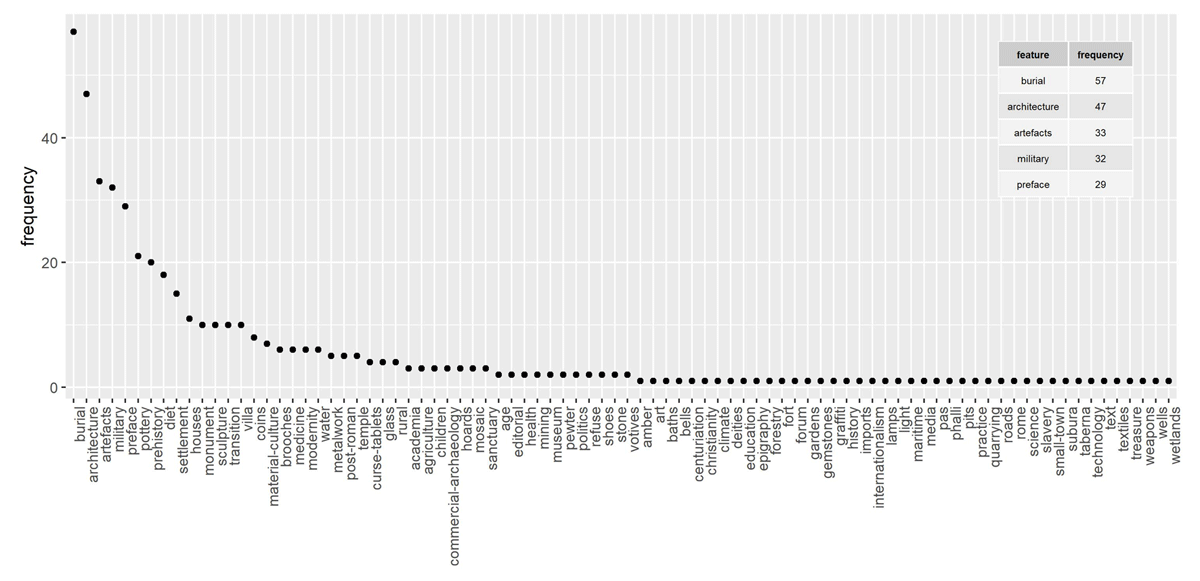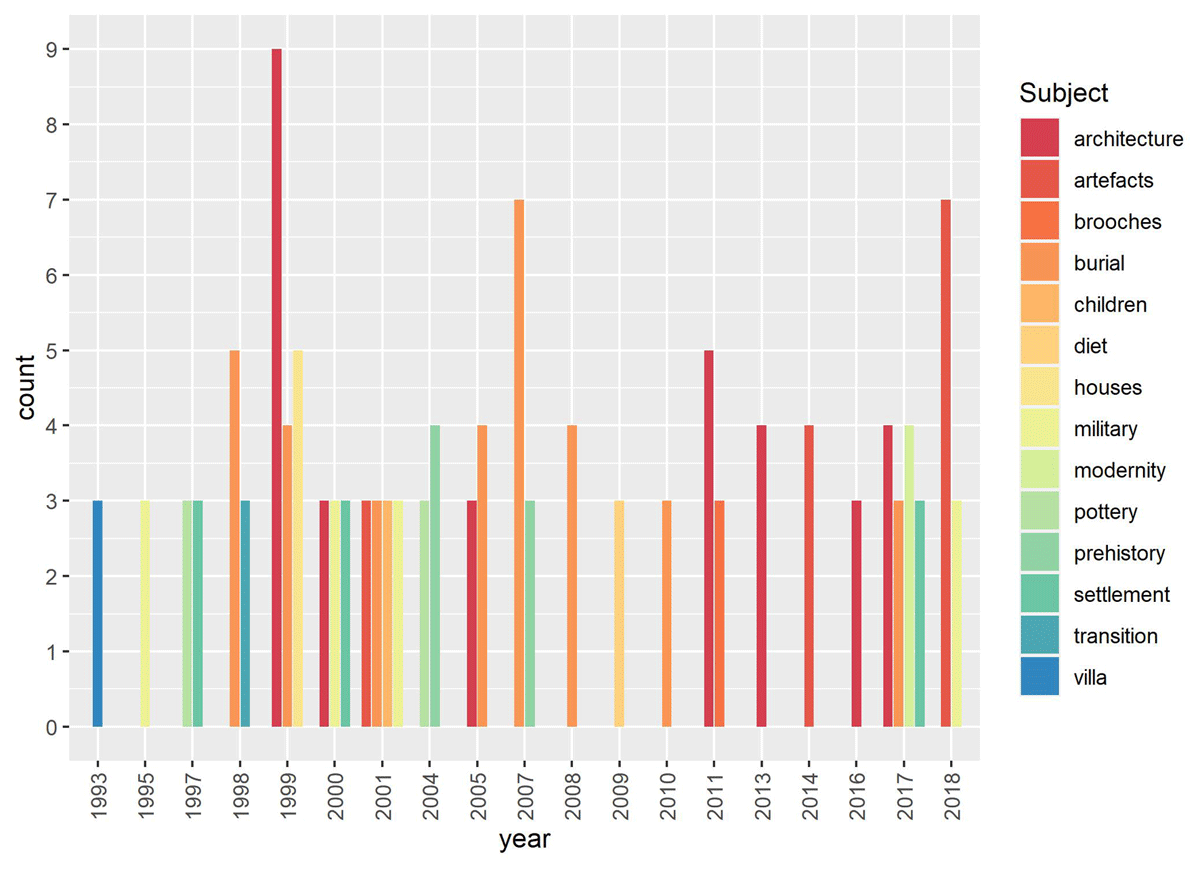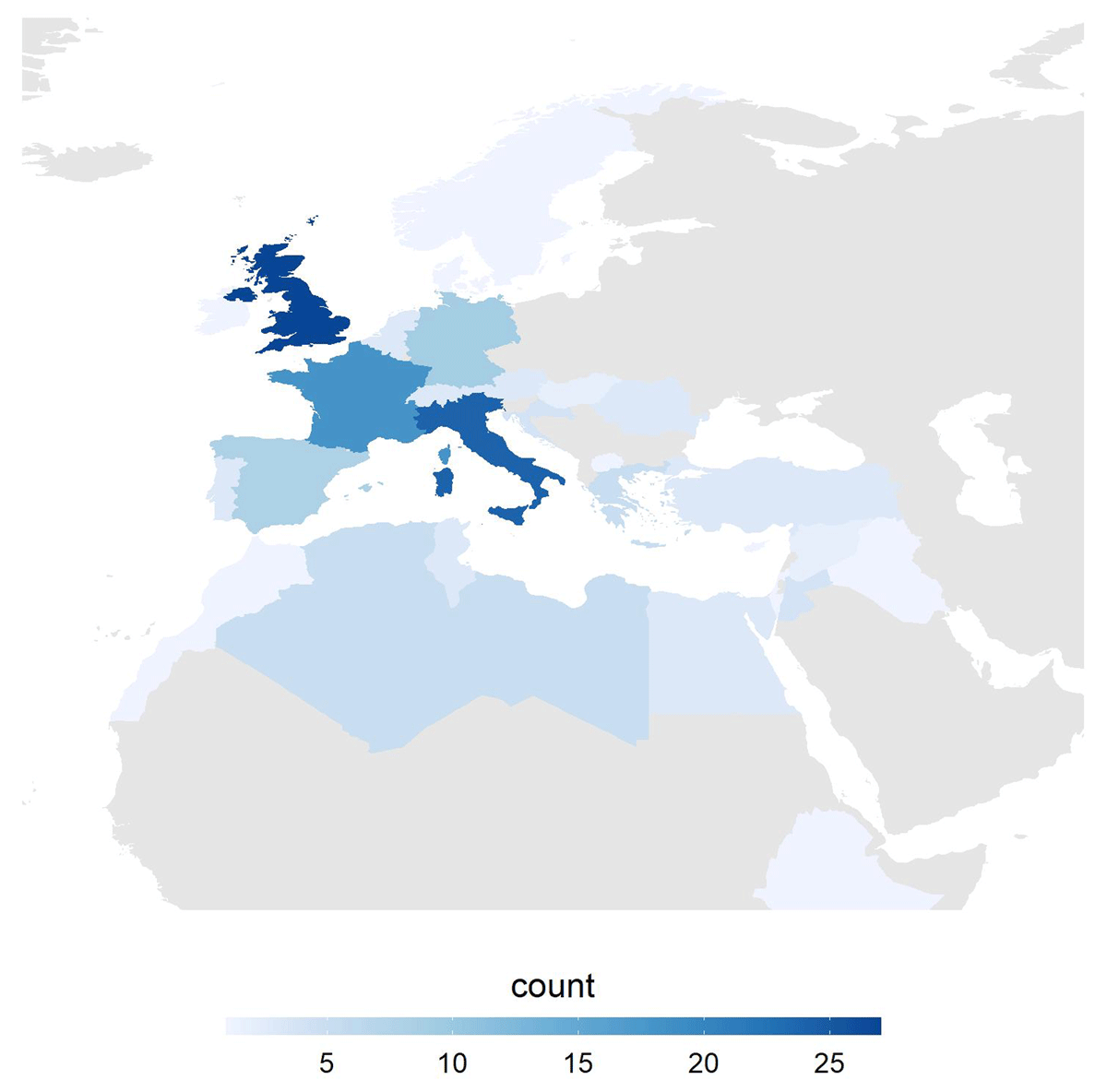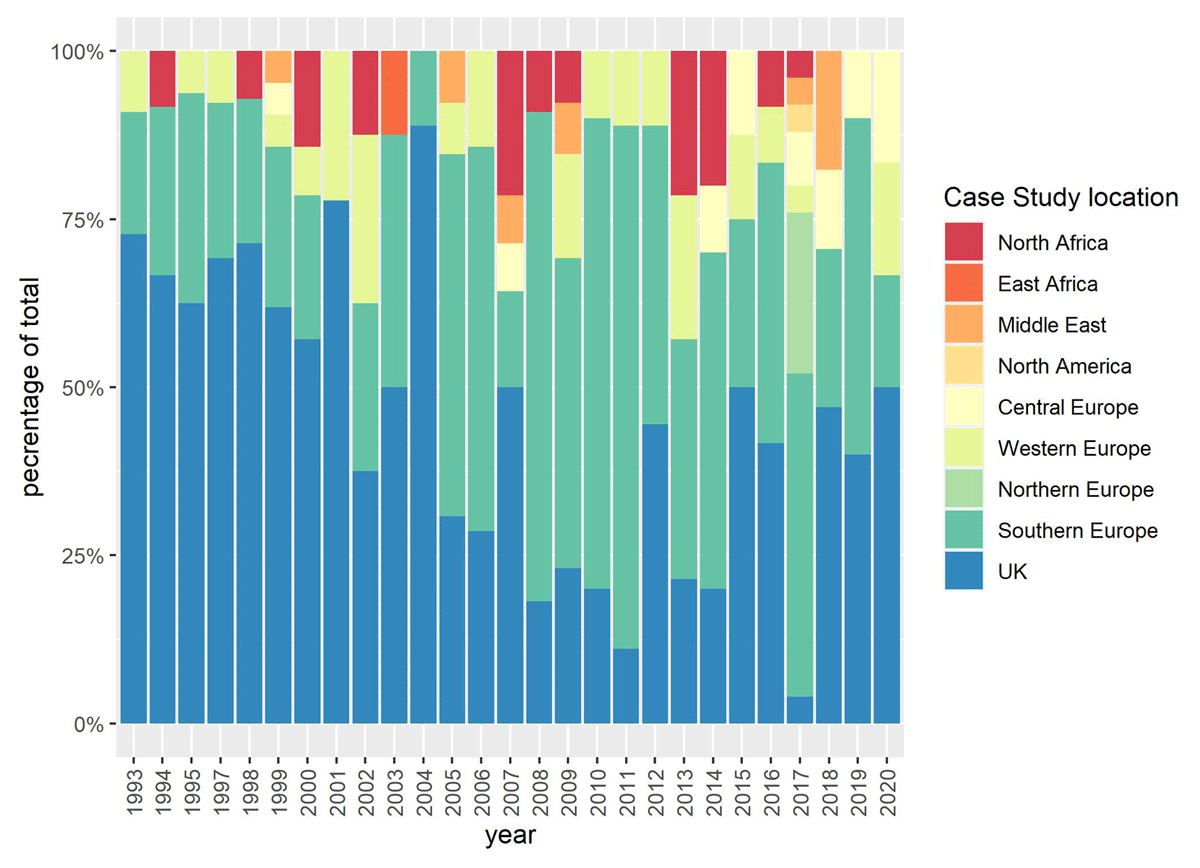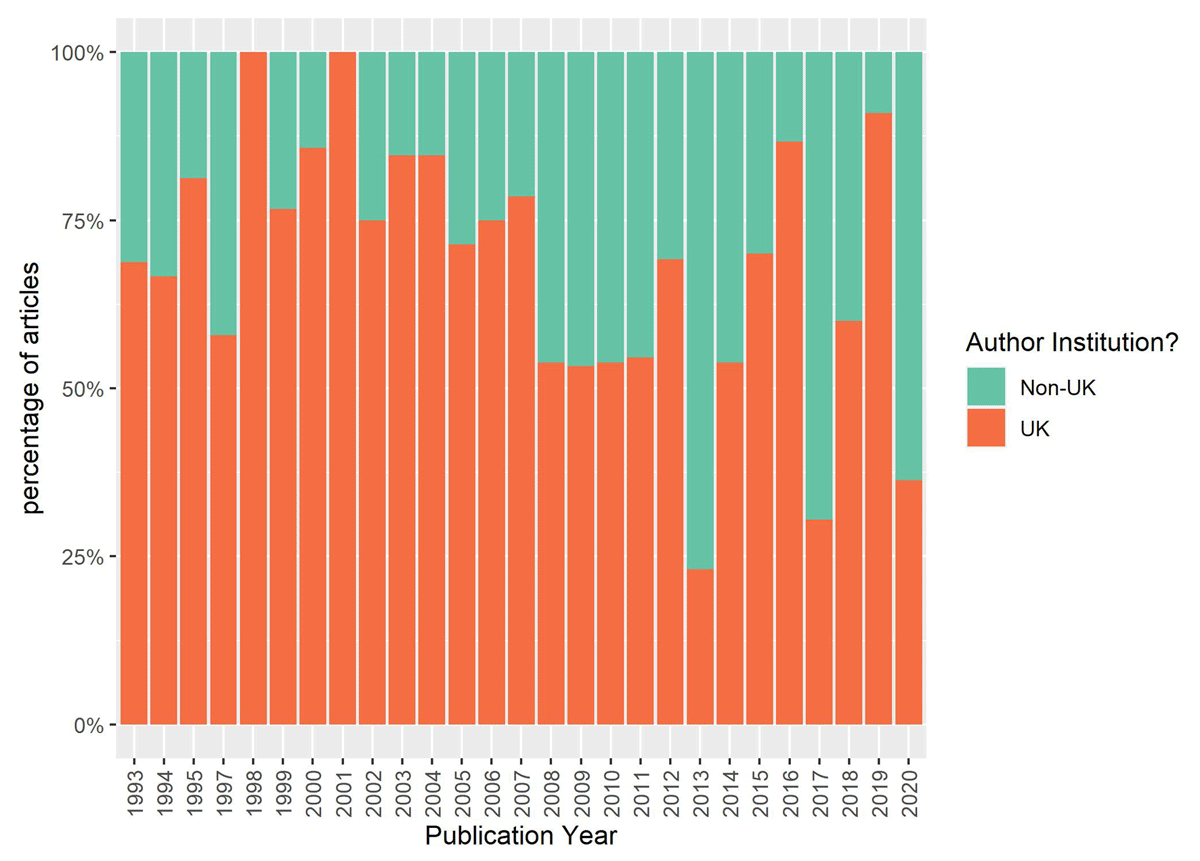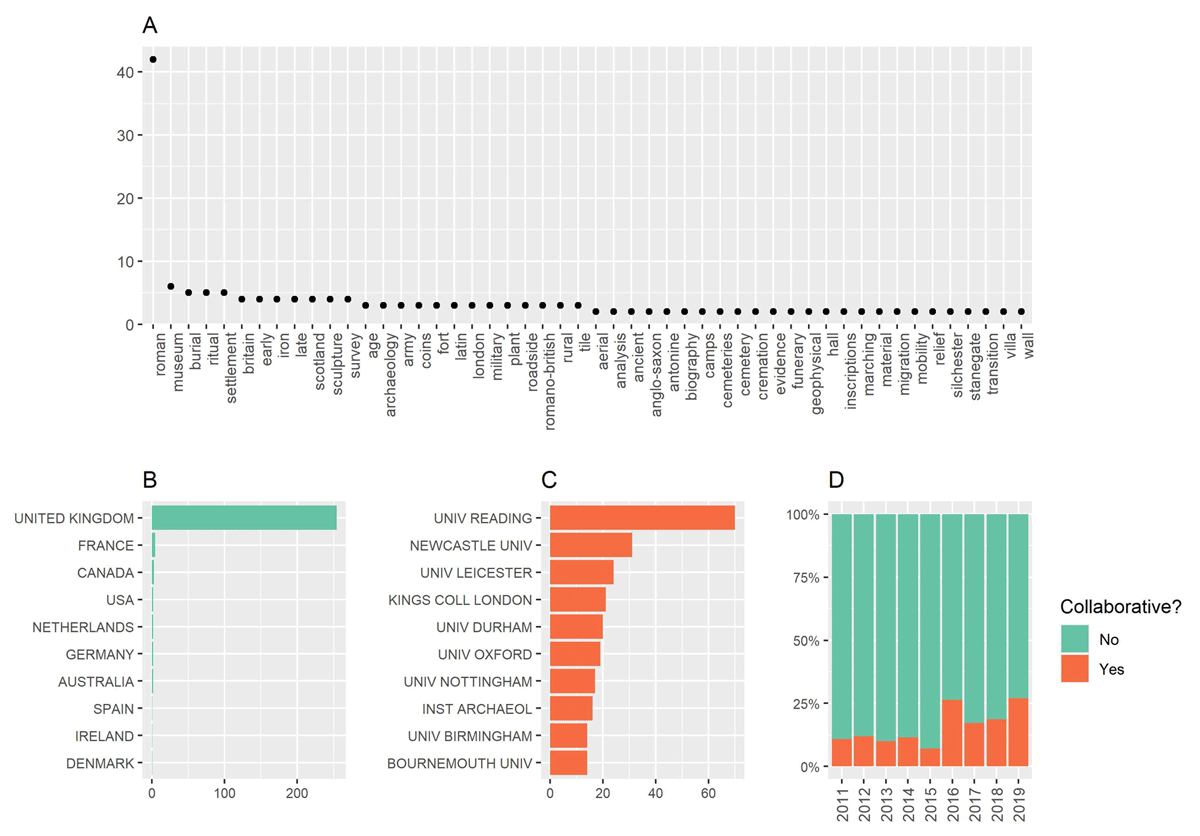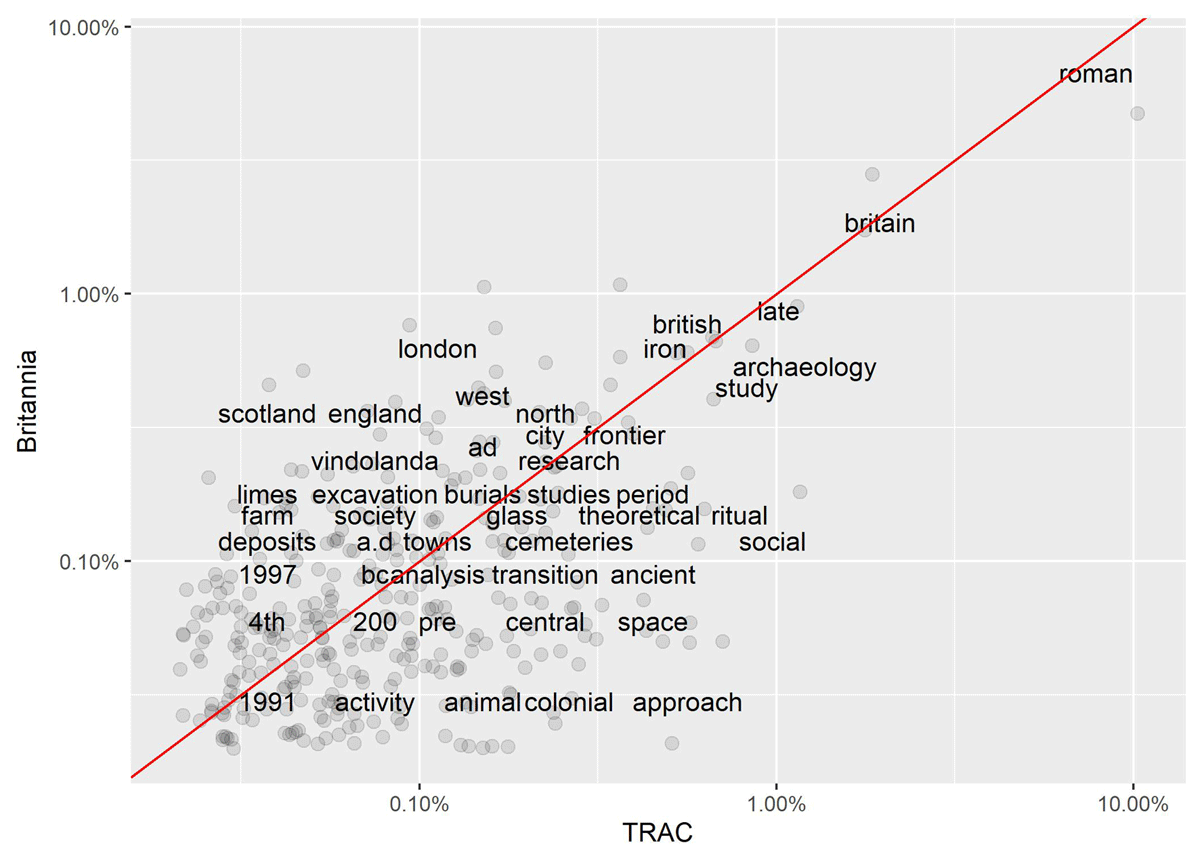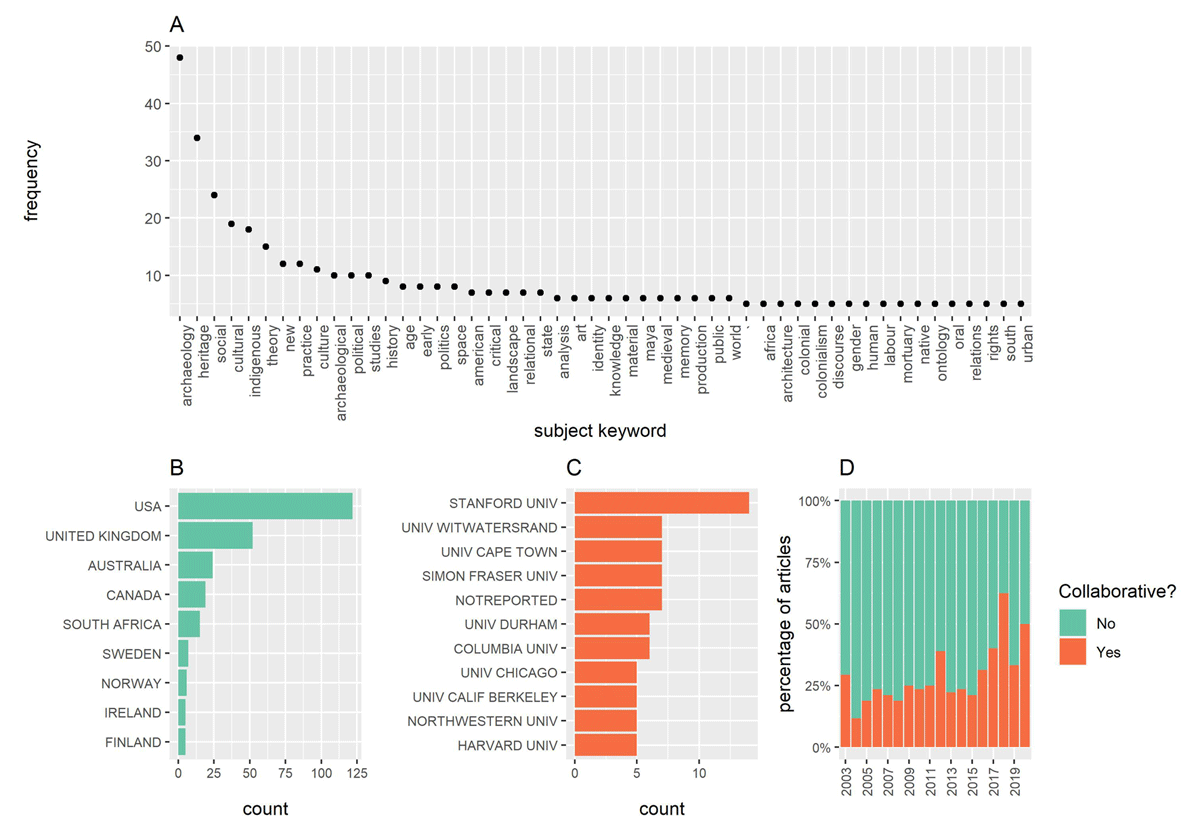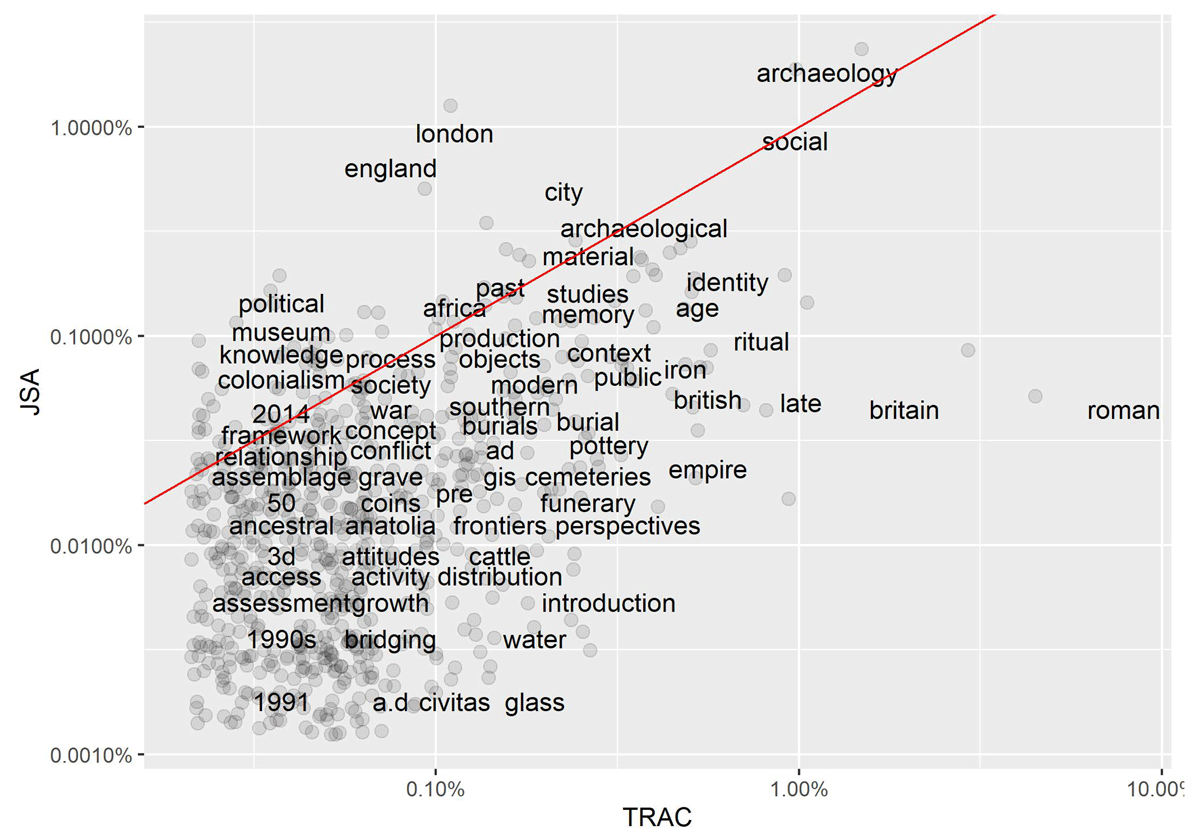Introduction
In 2021, TRAC turns 30 and has left quite a legacy. In that time the organisation has held 32 different events and published 31 different volumes, both online and in print, comprising 399 different articles.1 Part of this success can be contributed to the somewhat unusual TRAC tradition of regular introspection – articles and debates that have assessed the successes and failures of the conference over the last three decades. These reflections have been useful in driving forward change, however, they have often been internally led and lack a consideration of how TRAC is faring in the wider archaeological word (Gardner 2016). This paper focuses on TRAC publications as a proxy for understanding the changing foci of the TRAC community over the last 30 years. By utilizing both TRAC’s introspective practices and the data produced by the conference over the last 30 years, this analysis draws together the key aims of the conference and whether the organisation has been successful in achieving them.
This paper is divided into three sections. The first section determines the aims and objectives of TRAC by reviewing the critical reflection of the organisation in past literature. The second considers, through a detailed analysis of past TRAC publications, how well the conference has achieved its stated aims. The final section provides a comparative analysis of TRAC to the publications of similar sub-disciplines to consider the achievements of the conference and to provide a broader comparison to both Roman and theoretical archaeology (cf. Gardner 2016). This data driven analysis has been undertaken to better understand what research has been conducted under the umbrella of TRAC over the last 30 years and how we might move forward in the future.
A Brief History of TRAC
The Theoretical Roman Archaeology Conference (or TRAC) was founded by Eleanor Scott with the first event held at Newcastle University in 1991. The initial focus of the conference was to serve as an ‘arena for discussion of the introduction and operation of theory in Roman archaeology’ (Scott 1993: 1). In this regard, TRAC has been largely successful and although the conference has changed somewhat since its inception, it has provided a safe, open, and inclusive space, from which new and innovative theoretical approaches in Roman Archaeology have been developed (Gardner 2016: 1). As an organisation, TRAC was designed to be democratic and egalitarian (Scott 1993), a structure that has been broadly retained over the last 30 years. Each year different groups bid to run the following year’s conference at the AGM, allowing a new cohort to help guide the future direction of TRAC. The joining of TRAC to RAC (Roman Archaeology Conference) in 1995 has led to the certainty of the conference location every second year. Despite some initial concerns about this arrangement (Davies et al. 2001: v; Laurence 2006: 117), the move has been heralded as a positive step forward for ensuring the mainstream integration of archaeological theory into Roman studies (Laurence 2006: 117; Scott 2006: 113; Gardner 2013: 2; Michielin et al. 2019: 5) and a greater international audience (Mladenović and Russell 2011: iv; Michielin et al. 2019: 5). A TRAC standing committee was introduced in 2001, to ensure the continuity of the conference, promote it to the wider archaeology community, and ensure papers from the conference were published (Laurence 2006: 118).
TRAC publications
Publishing the outputs of the conference has been a key component of TRAC since its inception. Initially, publication was channelled solely through the conference proceedings, a collection of 8–12 papers presented at TRAC that year. Although publication of the conference proceedings was initially not met with ‘unanimous enthusiasm’ (Scott 2006: 113), the proceedings became a stalwart of TRAC, providing a tangible result and ‘legacy of each year’s efforts’ (Laurence 2006: 118). The editorial process for each year was run by the organising committee and generally followed a standard procedure (e.g. Platts et al. 2014). Following the conference, presenters were invited to submit papers as abstracts from which the editorial team selected a small number. Once submitted the full papers were scrutinised by the editors and anonymous peer reviewers, edited, resubmitted, and published. Contributions could be submitted from any session and as such the proceedings followed a ‘journal’ type format of broadly related articles (Laurence 2006: 121; Platts et al. 2014: 6), which generally reflected the general concerns and/or key themes of that year’s conference. Over the last 20 years there has been some critique of the TRAC proceedings (e.g. Laurence 1999; Webster 1999; Swift 2007; Revell 2014), with most reviewers favouring papers that ‘include both the consideration of a theoretical premise, and its application to a body of data’ (Revell 2014: 493).
In 2013 TRAC adopted an open access policy and an initiative from the standing committee saw the digitisation of past proceedings. By 2019 all TRAC proceedings were available as open access publications (TRAC 2020a). In 2016, the TRAC Themes in Roman Archaeology was established as the first ‘spin off’ from the existing conference proceedings. In contrast to the proceedings, this series was created to publish volumes that ‘focus on a particular theme, problem, or theoretical perspective’ (Rohl 2017). To date, three volumes have been published by Oxbow Books (González Sánchez and Guglielmi 2017; Parker and McKie 2018; Selsvold and Webb 2020), but the series has recently been discontinued, hopefully to remerge in the future in a different format (K. Crawford pers. comm.). The most recent innovation in TRAC publications has been the launching of the Theoretical Roman Archaeological Journal (or TRAJ). TRAJ was developed as an open access publication to replace the existing proceedings, which were concluded in 2017 following RAC/TRAC in Rome. TRAJ was founded to provide ‘a venue for innovative and interdisciplinary research in the field of Roman Archaeology’, promoting specifically the use of theoretical approaches ‘rather than solely the presentation of archaeological data’ (TRAJ 2020). TRAJ is hosted as an open access publication on the Open Library of Humanities (OLH), alongside the open access TRAC Proceedings (Hanscam and Quiery 2018: 1). The format has followed the ‘journal-style’ proceedings but additionally opened contributions to papers from outside the conference, allowing for more diverse and eclectic content. Today, TRAC publications represent a largely open access and large-scale corpus of literature that reflects diverse theoretical approaches to the Roman world.
A retrospective of introspection
TRAC is unusual for an academic society in terms of being particularly introspective. Although reflection upon publication practices within Roman Archaeology has been undertaken elsewhere (e.g. Terrenato 2002; Bagnall and Heath 2018), the scale of comparable introspection at TRAC is unparalleled. Stemming from the aims outlined by Scott (1993) at the first TRAC, it has become a tradition at significant anniversaries for leading figures from within the organisation to reflect on its successes and failures and ponder ‘where do we go from here?’ Such articles have been published in TRAC proceedings after 10 years (Davies et al. 2001), 15 years (Gardner 2006; Laurence 2006; Scott 2006), 21 years (Scott 2012) and 25 years (Gardner 2016). In addition, the preface of the conference proceedings and the editorials of the recently created TRAJ each usually focus on topics relevant to TRAC and its future at that time. Together these retrospectives provide a history to the development of TRAC and while it is not my intention to summarise each of these articles here, I do want to highlight some key themes that have remained consistent arenas of debate over the last thirty years.
Praxis
The first TRAC heavily focused on diversifying participants to include professionals from the field (i.e. commercial archaeology, curatorial roles) and museums. Although not a deliberate design of the conference, the location of TRAC 1991 (Newcastle University) provided organisers access to archaeologists from various organisations who were actively sought out (Scott 2006: 112). Despite this positive start, the lack of representation or participation from archaeological professionals at TRAC was noted as early as 2000 (Davies et al. 2001) and reiterated at the conferences 15th anniversary. At that time, some suggestions for widening participation included prioritised sessions for professionals, greater promotion of the conference (Gardner 2006: 131), and online platforms for continued debate (Laurence 2006: 124). While the original organisation of the TRAC Standing Committee was to include representatives from the field and museums (Laurence 2006: 118), this structure has been somewhat altered and members are now elected by participants at the AGM. Unfortunately, the lack of professionals at the conference has somewhat restricted their impact on the future of TRAC to purely attendance and publication, if possible. A recent analysis of TRAC conference speakers and session organisers, entitled ‘TRACking Diversity’ (Lodwick et al. 2017), has stated that the participation of speakers from outside universities remains low. Recently a session from TRAC 2018 on ‘The Praxis of (Roman) Archaeology’ sought to address this imbalance by providing a forum for tackling divisions within and between archaeological organisations. The subsequent publication acts as a manifesto for ‘redemption’, to build bridges between the systems that we operate and recognise that we should act collectively ‘to elucidate our shared past and humanity’ (Weekes et al. 2019: 14).
Research strands
As an organisation TRAC has two main thematic foci; the development of new theoretical approaches and the archaeological evidence for the Roman World. However, over the last thirty years the conference has often been heralded for its diversity of approaches, allowing TRAC to widen ‘the range of perspectives offered and voices heard’ (Hanscam and Quiery 2018: 1). Throughout the years some theoretical frameworks have been noted as being particularly popular at TRAC. They include an early interest in critiquing Romanization (e.g. Freeman 1997) and later a focus on identity studies (Pitts 2007: 709–710; Mattingly 2011: 208–209), while other subjects, such as gender studies, have repeatedly been ignored with some limited exceptions (Baker 2003; Laurence 2006: 122; Gardner 2016: 7). More recently, the TRAC thematic series has focused on specific theoretical strands, stemming directly from one or more sessions held at the conference. In addition, several multi-authored journal articles in TRAJ have brought focus to under-represented topics including the praxis of Roman archaeology (Weekes et al. 2019) and modelling and complexity science (Brughmans et al. 2019). Gardner (2016: 10) has recently argued that while TRAC’s multi-vocality may have led to theoretical fragmentation, TRAC can act as a venue to turn diversity into renewed dialogue.
Internationalism
Although initially a UK based organisation, TRAC has also increasingly expanded its scope to areas beyond the UK. While a small contingent of attendees from Europe was present in the early days of TRAC (Scott 1993: 3), the conference remained broadly anglophone for many years leading to internal critiques that lamented the absence of voices from outside the UK, while simultaneously acknowledging the difficulties of holding the conference abroad (Davies et al. 2001: v; Gardner 2006: 132). These critiques led to tangible results. Since 2008 the conference has been held outside the UK, in many instances in association with RAC, including in Amsterdam, (2008), Ann Arbor, USA (2009 – alongside a parallel Southampton conference), Frankfurt (2012) and Rome (2016) with the next to be held in 2022 in Split, Croatia (delayed from 2020 due to the Covid-19 pandemic). Amid this growing international presence there are continued calls to promote international perspectives both in terms of educational background and nationality of institution (Michielin et al. 2019: 2–4). Analysis of participants numbers from RAC/TRAC 2018 in Edinburgh saw almost half (43%) of attendees from UK institutions. However, positively the number of countries represented has risen from 15 at Amsterdam 2008 and Oxford 2010, to 17 at Leicester 2015 and 27 at Edinburgh (Michielin et al. 2019: 1).
Gender
From its inception, the promotion of gender studies and gender parity in the profession has been a key thematic issue for TRAC (Scott 1993: 2). However, despite initial intentions, calls for the greater consideration of gender issues were reignited 15 years later (Gardner 2006: 131–132; Laurence 2006: 122; Scott 2006: 111). In part, these critiques focused on a lack of interest in gender studies, typified by Patty Baker’s (2003) session at TRAC 2002 on ‘Interdisciplinary approaches to Roman Women’ that attracted only two speakers. Subsequent retrospectives have focused on gender parity in both conference presentations and for authors in the published proceedings (Platts et al. 2014: 6–7; Michielin et al. 2019: 2). From year to year the ratio of male to female presenters and/or authors has fluctuated both in a negative (Webster 1999: 123–124) and positive fashion (Platts et al. 2014: 6–7), however, overall Scott (2012: 2) has argued that TRAC has been somewhat successful in creating a platform for female archaeologists, leading to their work ‘re-valued from being ‘just’ whatever it was—‘small finds’, ‘gender stuff’, ‘babies’—to being actual archaeology.’ Finally, the recent ‘TRACking Diversity’ analysis has shown that female attendance has grown over time and that in recent years the gender balance has been generally good (Lodwick et al. 2017).
Method – Understanding TRAC
The research presented here focuses on better understanding the TRAC community through a large corpus of data produced since its inception; TRAC publications. Thirty years of TRAC publications provides a large and diverse dataset to assess developments in the organisation since the 1990s (Figure 1). Although TRAC has been particularly retrospective in this time, the approach in this paper is novel as it employs a bibliometric analysis of empirical data. Bibliometrics is the application of quantitative methods to analyse published academic literature (De Bellis 2009: xi). Interpreted through the theoretical lens of TRAC, the analysis of these publications can provide insights about the development of TRAC over time and allow us to assess, in part, the success and failures of three of its key concerns; praxis, research strands, and internationalism. Furthermore, TRAC publications can be used to understand how TRAC fits into the wider world of theoretical Roman Archaeology. As noted by Gardner (2016: 2), while there are benefits to TRAC’s tradition of critical reflection, these contributions are often ‘exclusively within the TRAC Community rather than outsiders that may help us shift our perspective.’ After all, TRAC was founded to draw theoretical debates held elsewhere into the realm of Roman studies.
TRAC publication database
TRAC publications, although predominantly open source, are currently not listed in bibliometric databases such as Web of Science (webofknowldge.com) or Scopus (scopus.com). Consequently, a bibliometric database of TRAC articles was created as part of this research. Each paper was downloaded from the OLH and reviewed for bibliographic data. Hardcopies of the three TRAC Themes volumes were consulted separately. The database was structured to reflect other bibliometric databases, separating parts of the citation (i.e. author, title, page references, journal type) into separate fields (Table 1). Information contained within TRAC articles on author number and institution was also included where presented, while additional information such as institution type and location were gathered from web searches, taking into consideration the year of publication.2 It should be noted that the large number of articles published in 1999 reflects the publication of the previous year’s conference proceedings (1998), as well as the delayed publication of the proceedings from 1993 (Figure 1). In addition, proceedings from the 1996 conference were not published. Although a volume was produced (Laurence and Berry 1998) from two sessions at the conference, this was not a TRAC organisation publication and has therefore been excluded from this analysis. The database was also constructed to address trends in the articles across three research strands: theoretical frameworks, methodology, and subject matter. Categorization was undertaken by extracting information from the title, abstract, and keywords (if applicable). If further investigation was required then the introduction and conclusion of the article were read and then the main body of text. Editorial sections of the TRAC proceedings and TRAJ were useful in providing a short summary of each article, however, the articles themselves were always consulted to ensure accuracy. Further details about each specific research strand are presented below. The database is included as part of this publication as a supplementary .csv file shared via a Creative Commons licence (CC BY 4.0) (Supplementary file 1).
Heading and descriptions of fields in the TRAC publication database.
| Headings | Description |
|---|---|
| authors | Name of article author(s) |
| title | Title of article |
| journal | Journal title |
| year_pub | Year of publication |
| pages | Page numbers of articles |
| journal_issue | Volume number |
| number_authors | Number of authors |
| collaborative | Was the article multi-author? |
| full_reference | Full reference of article |
| lead_author_institution | Institution name of first author of article |
| institution_country | County of lead author institution |
| country_topic | Countries used as case studies |
| institution_type | Type of author institution |
| theory_topic | Theory topics used in article |
| subject_topic | Subject of article |
| method_topic | Methods used in articles |
| type | Type of article |
Revealing the TRAC community
It is important to note that the following analysis was designed to reflect the TRAC community through a specific dataset, namely TRAC publications, rather than the wider corpus of papers presented at the annual conference. The TRAC proceedings were produced to provide a “snapshot” of the contents of the conference, however, due to the submission process and the short editorial timeframe it has been argued that it may not be a true representation of the key debates or themes for that year (Laurence 2006: 119; Platts et al. 2014: 6). The analysis of TRAC publications provides a broad overview of the TRAC community, rather than representing the identity of individual authors. This is an important distinction due to the difficulty of accurately establishing identity traits (i.e. gender, status, age, employment) purely from author names. Identity is complex, multi-faceted, fluid, and liable to change (Meskell 2007), particularly over the 30-year history of TRAC. Recently authorship identity has been analysed by feminist scholars by conducting an author survey, allowing self-identification in terms of gender, ethnicity, sexual-orientation, and nationality (Heath-Stout 2020: 5–7). Some important research into these issues at TRAC have been undertaken by Zena Kamash (2019) as part of TRAC 2019 plenary lecture entitled ‘Decolonizing Roman Archaeology’. By reviewing session organisers and paper presenters from TRAC conferences Kamash (2019) has sought to distinguish the diversity of TRAC participants, in terms of gender and ethnicity. Preliminary results suggest that the diversity of TRAC is extremely limited, in tandem with much of academia, and there is much to do to decolonise Roman studies.3 This research utilises information from the articles themselves and does not seek to assume aspects of the authors identity. As such the consideration of gender, although an important topic for TRAC and more generally, is only considered as a research strand. A truer picture of the TRAC community would analyse together publications, papers presented, and active participants of TRAC conferences. Through an analysis of the publication corpus, this research provides a first step to better understand the collective identity of TRAC.
Comparative bibliometric analysis
Bibliometric analysis has been used in various forms to better characterise the multidisciplinary nature of archaeological research (Sinclair 2016). Specific studies include establishing trends in archaeological science (Marriner 2009), the influence of academic background on research (Mallía and Vidal 2009), trends in osteoarchaeology (Mays 2010), network analysis (Brughmans 2013; Brughmans and Peeples 2017), the use of R software (Schmidt and Marwick 2020), and gender disparities in publishing (Victor and Beaudry 1992; Beaudry and White 1994; Hutson 2002; Hutson 2006). Although archaeology is an interdisciplinary field, it is important to determine how alike TRAC is to our nearest sub-genres. Some bibliometric analyses have identified a vast difference between humanities and science focused archaeological journals, in terms of cross referencing, thematic foci, and methodological application (Jorgensen 2015: 137). In many instances, bibliometrics utilises citation numbers to determine the impact of research and network analysis to determine the connections between different fields. However, as TRAC publications are not included within the usual bibliometric databases it is currently difficult to compare these aspects across publications. It is possible, however, to use data from journals found in bibliometric databases to compare similar facets. This research utilised bibliometric data downloaded for archaeological journals to compare author institution and country over time, as well as rates of collaboration.
Reproducible research
The bibliometric analysis in this article was undertaken using the R programming software (R Core Team 2018), specifically the tidyr (Wickham and Henry 2020) and bibliometrix packages (Aria and Cuccurullo 2017). The code was partly adapted from recent research undertaken by Schmidt and Marwick (2020). In order to make this research open and reproducible (e.g. Marwick 2017), the R code used for the analysis and visualizations from this paper (Supplementary file 2) and the data downloaded from Web of Science for both Britannia and the Journal of Social Archaeology are included (Supplementary file 3 and 4) as supplementary files. In accordance with the TRAJ editorial policy, these files are offered here under a Creative Commons licence (CC BY 4.0).4
Results – TRAC Publications
Praxis
The collaboration between university-based research and the practice of archaeology, predominantly through developer-led archaeology, has seen recent success in Roman studies. The Roman Rural Settlement Project has led to important recommendations to how we should improve archaeological practice in Roman studies and beyond to advance research objectives (Fulford and Holbrook 2011; 2018). Despite these important advancements, there has been little understanding of the parallel role of theory and practice in Roman studies. Examining the institutions that TRAC authors originate from can help us, in part, to determine what fields of heritage are dominating advances in archaeological theory. An analysis of the data suggests that most authors (85–90%) were affiliated with a university (Table 2). After those authors who did not state their affiliation (‘unknown’), the remaining institution types were each represented by low numbers. These groups include commercial archaeology companies (i.e. contractors and consultants), museum bodies (including local, regional, and national examples), and heritage bodies, whether national (i.e. Historic England) or local authority representatives. In a minority of cases international organizations were represented including UNESCO. It should be noted that this data reflects only the affiliation that authors are willing to provide. At a University dominant conference, such as TRAC, it is likely that article authors would advance their university affiliation over others. For example, I was working full time in commercial archaeology while undertaking doctoral research but in each instance only used my University affiliation to reflect the source of my research.
Institution types of publication authors (all years).
| Institution type | Article frequency |
|---|---|
| University | 342 |
| Unknown | 14 |
| Research Centre | 8 |
| National museum | 5 |
| Commercial archaeological contractor | 4 |
| Independent | 4 |
| Local museum | 4 |
| National heritage body | 4 |
| Regional museum | 4 |
| Archaeological consultancy | 3 |
| International organisation | 3 |
| Local Authority | 2 |
| Heritage trust | 1 |
| Regional heritage body | 1 |
A consideration of author institutions over time (Figure 2) reiterates the dominance of university affiliations since the beginning of TRAC, however, it also shows that other institution types, particularly other heritage bodies and museums, were better represented in the early years. The lowest levels of non-university affiliation appear to correlate to a period ten years ago, suggesting there was little improvement in that time. Worryingly, contributions in 2020 were entirely from university affiliated authors, although this was after several years of slow growth in contributions from outside universities (2014–2019).
The data also reveals a strong correlation between author institution and conference location. Since the beginning of TRAC thirty years ago, every conference has been held in a university setting. In part this reflects the capabilities of different institutions. University staff have the time and capacity to organise conferences at their institutions, where public gatherings in the commercial sphere tend to centre around community archaeology and satisfying public curiosity. It appears that conference location is an important factor in participation in publication. The ten largest contributing institutions to TRAC articles (Table 3) align closely with the ten most frequent locations of conferences over the last 30 years (Table 4). In each case universities at Durham, Leicester, Newcastle, and London (UCL and Kings College London) top each list.
Ten largest contributing author institutions for all TRAC publications.
| Institution | Article frequency |
|---|---|
| University of Leicester | 30 |
| Durham University | 25 |
| Newcastle University | 18 |
| University College London | 14 |
| University of Birmingham | 14 |
| University of Southampton | 14 |
| University of Kent | 12 |
| University of Cambridge | 11 |
| University of Reading | 10 |
| University of Sheffield | 10 |
Ten most frequent institution that have hosted a TRAC Conference.
| Location | Frequency | |||
|---|---|---|---|---|
| Durham, UK | 4 | |||
| Leicester, UK | 3 | |||
| London, UK | 3 | |||
| Newcastle-upon-Tyne, UK | 2 | |||
| Glasgow, UK | 2 | |||
| Reading, UK | 2 | |||
| Glasgow, UK | 2 | |||
| Canterbury, UK | 2 | |||
Collaboration is an under researched avenue in TRAC publications and research. While the conference is a highly collaborative atmosphere, particularly in the creation of sessions, there has been little quantitative analysis of how much research is undertaken individually or as part of a collective. For TRAC publications this facet was analysed by examining whether articles had single or multiple authors (Figure 3). For each year of publication, less than 25% of articles were multi-authored suggesting that the level of collaboration in TRAC publications is low. However, the overall number of multi-authored papers has increased in number since 2010, particularly in the years since the creation of TRAJ. Several recent multi-authored TRAJ articles have been produced from sessions held at the conference and represent the articles with the greatest number of co-authors (Brughmans et al. 2019; Weekes et al. 2019).
Further research on collaboration at the conference, both in session organisation and paper presenters, will be addressed in a future TRAC session (Garland forthcoming). Preliminary research suggests that while most sessions are the result of collaborative organisation, multi-authored presentations are in the minority. Further action is needed to transfer the collaborative efforts apparent across much of Roman studies into tangible outputs, such as presentations and publications.
Research strands
Traditional bibliometric analysis attempts to understand research strands within publications by evaluating the frequency of words in paper titles, usually presented as a word cloud. Although useful in determining broad trends, this is a coarse technique that does not appreciate subtle differences in research foci or the consideration of changes over time. Consequently, to determine different research strands in TRAC publications keywords were assigned to each article for three major themes; type(s) of theoretical framework, methods utilised, and subjects of research (i.e. type of archaeological material/remains studied). For each theme, two avenues were addressed. Firstly, the frequency of each term used across all TRAC publications, to determine the popularity of specific categories. Secondly, for those terms most frequently used, the frequency per year to explore trends over time. The categorisation process was determined by a detailed examination of each article (see above) including the title, abstract, keywords, and main body of text. Where multiple approaches were utilized (i.e. landscape and identity — Garland 2016) an entry was included for both for that article. Although some characterisations could have been grouped together (i.e. practice and structuration) there was a conscious effort to use terminology portrayed in the article rather than group theoretical approaches based on an assumption of their usage. If no obvious theoretical or methodological approach could be identified then no entry was included.
Theory
Determining the theoretical approaches in TRAC articles was relatively straightforward as this aspect is usually explicitly declared in each article. A consideration of the different theoretical approaches demonstrates, unsurprisingly, the vast diversity of frameworks apparent in TRAC articles (Figure 4). The frequency of terms indicates the dominance of ‘identity’ and ‘landscape’ approaches, as well as a focus on ‘society’, ‘ritual’, and ‘space’. Interestingly, ‘gender’ received the seventh highest usage, tying in overall number with ‘urbanism’ and practice-based approaches. This high number contrasts with limited interest in previous conference sessions on gender (see above) but may reflect the focus of TRAC to address the underrepresentation of this important topic. The focus of the TRAC thematic volumes (frontiers, magic, posthumanism,) were each found in the top 20 of utilised terms, suggesting that focused issues were successful in increasing research into these topics.
To determine trends in theoretical approaches, the relative frequency of categories used per year was plotted for each term used more than five times in any given year (Figure 5). Several groups of theoretical approaches were apparent in 1999 including ‘practice’, ‘romanization’, ‘space’, and ‘urbanism’. This year saw the publication of two proceedings (Baker et al. 1999; Leslie 1999), one of which was delayed from TRAC 1993, resulting in a disproportionate range of approaches. In some instances, the results appear to suggest correlations between sessions held at the conference and subsequent publications. The large number of papers published on ‘urbanism’ in 2013 reflect the publication of several presentations from a single session on ‘Roman Neighbourhood Relations in Urban Contexts’ (Bokern et al. 2013: ix). In recent years groups of articles resulted from the introduction of the TRAC thematic series. The trends show a rise in articles on ‘identity’ in 2017 (González Sánchez and Guglielmi 2017), ‘magic’ in 2018, (Parker and McKie 2018) and ‘posthumanism’ in 2020 (Selsvold and Webb 2020). Other popular TRAC topics, such as ‘identity’, ‘agency’, and ‘ritual’ are also present but do not appear to relate to a single conference session or year and likely represent a general interest in these topics.
Method
The number of method categories used suggests a heavy focus on the use of historical texts and epigraphy (Figure 6), but a diverse range of approaches that stretches to the use of statistics. The emphasis on ‘historiography’, used here to critique past archaeological writing rather than historical texts, demonstrates the role of theoretical archaeology to challenge past orthodoxies. The relatively high rank of ‘retrospective’, used here to refer specifically to TRAC retrospective articles (discussed above), confirms the self-reflective nature of TRAC. Encouragingly, scientific approaches such as ‘zooarchaeology’, ‘GIS’, and ‘archaeobotany’, are also predominant methods.
The frequency of method categories per year (Figure 7) was less diverse than for theoretical approaches. Trends in this data demonstrate a focus on ‘epigraphy’, ‘history’, and ‘historiography’ in earlier years (1995, 1999, 2000) and a focus on ‘retrospection’ in 2006 at TRACs 15th anniversary (Gardner 2006; Laurence 2006; Scott 2006). Promisingly, the range of methodological approaches in 2017, representing both the last TRAC Proceedings and the first TRAC Thematic volume, suggest that TRAC authors represent a variety of specialisms, combined under a common aim to utilise theoretical approaches to understand the Roman world.
Subject
The term ‘subject’ in this instance refers to the topic examined in each research article, specifically the archaeological material or remains studied. Examining the frequency of each term (Figure 8) demonstrates that popular subjects include ‘burial’, ‘architecture’, ‘artefacts’, and the ‘military’. The phrase ‘preface’, the 5th most popular term, relates to the introduction chapters or editorials included in each of the TRAC publications. Figure 10 also demonstrates the variety of subject matters in TRAC publications with a large proportion (approximately 40% of all categories) represented in a single article.
In considering the occurrence of subjects over time, the following figure displays little evidence for dramatic changes over time, but that popular subjects, such as ‘architecture’ or the ‘military’, reoccur from one year to the next (Figure 9). The predominance of certain terms, such as ‘architecture’ in the 1999 proceedings, can be related to specific sessions at TRAC 1998, as three of the total six related to architecture in some way. The range of subject terms in 2017, as seen with methods, likely represent the publication of two volumes in a single year.
Internationalism
Determining the levels of internationalism in TRAC publications has been analysed in two ways; the location of case studies used within articles and the location of authors based on their stated institutions. Case study location from TRAC articles acts here as a proxy for the geographic focus of theoretical Roman studies. For the purposes of this research, past locales were translated into modern countries to plot case study locations using modern mapping. Unsurprisingly, the location of most research case studies falls within or immediately surrounding the extent of the Roman Empire. In only one instance was this not the case: Irvin’s (2017) comparative analysis of Gallic and American societies reaction to the political organisation of the Roman Empire. The following figure (Figure 10) provides a density map of case study locations, demonstrating the dominant use of case studies based in the UK, Italy, or France. UK case study locations vastly outweigh other locations, while the vast majority are isolated to just five different countries (Table 5). On a positive note, it is encouraging to see that TRAC articles have included case study locations for most locations across modern Europe and northern Africa, although with a limited focus on Eastern Europe.
Ten most frequent case study locations utilised in TRAC publications.
| Location | Article frequency |
|---|---|
| UK | 143 |
| Italy | 62 |
| France | 23 |
| Germany | 13 |
| Spain | 10 |
| Greece | 5 |
| Turkey | 5 |
| Libya | 5 |
| Algeria | 5 |
| Netherlands | 5 |
Examining the use of case study locations over time, we see a general trend of greater diversification throughout the lifetime of TRAC (Figure 11).5 Focusing specifically on those years that followed a TRAC conference held outside the UK (2009, 2010, 2013, and 2017) there is both a greater diversification of case study locations and a larger percentage of locations from outside of the UK. This increase in diversity may demonstrate the success of European conferences at encouraging wider participation of European academics in the conference and the following proceedings. Despite these positive trends, since 2018, approximately 40–50% of case study locations from TRAC articles are UK based. This trend may reflect a change in publication type, with the first two TRAC Theme series originating from sessions held at UK based conferences (Gonzalez Sanchez and Guglielmi 2017: vii; Parker and McKie 2018: 1), and TRAJ, thus far, only published in years following UK based conferences.
The location of author institutions also shows a heavy bias towards the UK. It should be noted that the location of author institution does not determine the nationality of the authors themselves but serves here as a metric to determine whether TRAC is reaching and involving institutions beyond the UK. A breakdown of article numbers per institution country, with the UK split into its component countries (England, Northern Ireland, Scotland, Wales) demonstrates the dominance of authors from English institutions in the publication of TRAC articles (Table 6).
Ten most frequent countries represented by author institutions in TRAC publications.
| Location | Article frequency |
|---|---|
| England | 250 |
| USA | 26 |
| Unknown | 19 |
| Germany | 16 |
| Netherlands | 16 |
| Scotland | 15 |
| Italy | 10 |
| Amsterdam | 6 |
| France | 6 |
| Wales | 6 |
This bias is unsurprising given the limited number of conferences that have been held in the UK but outside of England (Glasgow — 1993, 2001; Edinburgh — 2018; 3 out of 26). If we consider the location of author institutions per year, the data demonstrate the dominance of UK based institutions since TRAC’s inception, but also encouragingly a growing trend of author institutions that are based outside the UK (Figure 12). This trend is starkly apparent in 2013 and 2017, the years following international conferences (Frankfurt and Rome respectively) and supports the notion that conferences held outside the UK strongly encourage international participation.
Comparative Bibliometric Analysis
Bibliometrics is a powerful tool in comparing the outputs of different publications. Two journals were selected to compare with the TRAC publication database — Britannia and the Journal of Social Archaeology (hereafter ‘JSA’). These journals were chosen in part due to the availability of data, as each is represented in the Web of Science database, but also to represent distinct genres of archaeological research that share characteristics with the aims of TRAC, namely Roman studies (Britannia) and theoretical studies (JSA). Four aspects were extracted from the bibliometric data of each journal; word frequency in article titles (to provide evidence of research strands), author institution location and type (to determine praxis and internationalism), and proportion of multi-author articles (to determine levels of collaboration). In addition, a direct comparison between TRAC publications and each journal is presented in a plot that compares the frequency of words used in article titles. Following a method developed by Schmidt and Marwick (2020: 22–23), the proportion of words used in the title of all articles within each publication will be plotted against one another. Words near the red line are used with about an equal frequency by articles in each publication set, while words away from the red line are used more by one publication than the other. This method provides a broad comparison of the research foci for each publication.
Britannia
Britannia is an annual peer-reviewed academic journal produced by the Society for the Promotion of Roman Studies. Britannia is composed of research articles, shorter papers, book reviews, and an annual summary of new archaeological discoveries within Roman Britain (The Roman Society 2020). Although focused primarily on the archaeology and history of Roman Britain, the journal also includes ‘kindred studies’, namely related subject matters including ‘the Late pre-Roman Iron Age, the post-Roman period, other provinces of the Roman Empire’ (The Roman Society 2020). A recent editorial review of the journal coinciding with its 50th anniversary demonstrated an imbalance in authorship, characterised by a depressed number of contributions from female and early-career researchers and those from outside universities (Eckardt 2019). In response, the journal’s editorial board are encouraging contributions from under-represented groups and for editorial members from outside university settings (Eckardt 2019: 8). This comparative analysis included the contents of the journal available online (2012–2019). Although the composition of the journal may not be directly comparable to TRAC publications, all articles have been included as they accurately reflect the contents of the journal, while the number of articles (n = 407) provides a broadly comparable dataset.
Although not ideal (discussed above), the word frequency from Britannia article titles act here as a proxy for the research themes from the journal (Figure 13a). The word frequency unsurprisingly demonstrates a preoccupation with the Roman period, however, the frequency of remaining topics is evenly distributed with some focus towards ‘museums’, ‘burial’, ‘ritual’, and ‘settlement’. Contributions overwhelmingly come from UK-based institutions with very small numbers from Europe, North America, and Australia (Figure 13b). This UK weighting, comparable to TRAC publications (Figure 12), is expected given the focus of the journal on Roman Britain. The frequency of author institutions is also dominated by UK universities (Figure 13c), in agreement with research by Eckardt (2019: 4–5) and is also comparable to TRAC (Figure 2). Collaborative authorship in Britannia appears low (Figure 13d), even in comparison to TRAC (Figure 4), but appears to be increasing over time, with the highest proportion in the latest issue (2019).
The frequency comparison plot between Britannia and TRAC publications (Figure 14) demonstrates the high concurrence rate of terms comparable to each publication type, such as ‘Roman’, ‘Britain’, and ‘archaeology’. In terms of subject matter ‘landscape’, ‘burials’, ‘glass’, and ‘towns’ also have a high concurrence between publications, suggesting similar subject matters. In contrast, terms that are frequent in TRAC publications but low in Britannia are ‘social’, ‘identity’, ‘cultural’, and ‘colonial’, relating specifically to theoretically driven research. Whilst terms frequently used in Britannia are geographical (‘London’, ‘England’, ‘Scotland’), likely reflecting the annual summaries of archaeological discoveries.
Journal of Social Archaeology
The Journal of Social Archaeology is a peer reviewed academic journal, publishing research articles across three issues a year. Unlike Britannia, JSA is not affiliated with a specific academic society but is theoretically focused and interdisciplinary in nature, engaging with related disciplines including ‘feminism, queer theory, postcolonialism, social geography, literary theory, politics, anthropology, cognitive studies and behavioural science’ (Journal of Social Archaeology 2020). The journal was founded in 2001 by its editor, Professor Lynn Meskell from the University of Pennsylvania (recently Stanford University). There is also a UK based editor and an extensive editorial board encompassing scholars from across the world. From its inception the journal aimed to ‘explore the relations of archaeology to the humanities and social sciences’, break down the divide between North American and European archaeologies, and ‘advocate innovative modes of writing [and] presentation’ (Journal of Social Archaeology 2001: 10–11). This comparative analysis included the contents of the journal available online (2003 to present) and provides a comparable dataset in article numbers (n = 303).
The word frequency of JSA articles confirms its focus on ‘archaeology’ and ‘heritage’, as well as theoretical foci, including ‘social’, ‘cultural’, and ‘indigenous’ concerns (Figure 15a). Contributions are dominated by Western countries including the USA, UK (where the editors are based), Australia, and Canada (Figure 15b), in contrast to the European focus of TRAC. Again, author institutions are dominated by universities, including Stanford, where its founding editor was based until recently. Interestingly the highest frequency of author institutions includes two universities from South Africa and one from Canada, demonstrating the international reach of JSA (Figure 15c). Finally, collaborative authorship is mostly low, with most issues containing less than a quarter of multi-author papers (Figure 15d). However, like TRAC, collaboration does appear to be on the increase. JSA issues published in 2018 and 2020 contained 50% or more articles produced by more than one author, a much higher rate than seen either in TRAC or Britannia.
The direct comparison between JSA and TRAC (Figure 16) shows a high concurrence rate of terms relating to theoretical driven research such as ‘archaeology’, ‘social’, ‘material’, ‘process’, ‘society’, and ‘colonialism’. Frequent terms in TRAC publications that remain low in JSA relate to the focus on the Roman World (‘Roman’, ‘Empire’) as well as Britain. However, terms such as ‘London’ and ‘England’ are frequent for JSA, potentially demonstrating a split in the use of terminology between the UK and USA. The subject of research differentiates between publications as well. In TRAC, material-based research is predominant, including terms such as ‘glass’, ‘pottery’, and ‘coins’, while frequent terms in JSA and not in TRAC include ‘political’ and ‘museum’, suggesting differences in the focus of theoretical research.
Comparing TRAC
On a broad level, TRAC compares favourably to related societies and journals. This limited comparison demonstrates that associated publications face similar dilemmas in attracting participation from outside universities and from beyond their ‘home’ country. In these terms, TRAC is ahead of the game by acknowledging these issues early and taking action to see improvement. Furthermore, while it appears that TRAC shares similar research foci with both Britannia and JSA, there are some differences in approach, with TRAC favouring both a theoretical basis and a material-based subject matter. Beyond these broad level comparisons, it is currently difficult to isolate more complex theoretical connections or divisions, either within TRAC (i.e. Gardner 2016: 1–3) or to related publications. From the bibliometric data collected it is possible to detect that several authors have published articles in both TRAC publications and one or both journals discussed above and these direct connections may have had a demonstrable effect on the development of TRAC. Anthony Sinclair’s (2016) wide-ranging analysis of archaeological research outputs demonstrates the effectiveness of citation analysis for understanding networks of communication between authors and across disciplines. Through understanding co-citation practices, defined as detecting groupings within research based on the similarity of sources cited, we could better understand the development of theoretical trends in TRAC research over time and how this development falls within broader trends in Roman studies and archaeological theory. Moreover, understanding citation practices are important in detecting inequality in gender and race (e.g. Victor and Beaudry 1992; Beaudry and White 1994; Hutson 2002), which is an important step in decolonising Roman archaeology (Kamash 2019). The current inability to undertake a citation analysis of TRAC publications stems from its exclusion from bibliometric databases and this should be a future priority for the organisation.
Conclusion: What Next?
The last 30 years of TRAC has seen some impressive achievements; an enduring conference, a body of high-quality publications and, more importantly, the creation of an open, inclusive, and cohesive community. Although TRAC’s tendency for reflexivity has highlighted some concerns (Gardner 2016: 1), over the last decade the organisation has sought to address these problems head on. The increasing internationalism of TRAC has been due, in no small part, to taking the conference abroad on a repeated basis, leading to greater international participation both in the conference and through TRAC publications. However, this analysis has highlighted that there is still much to do. The dominance of UK universities, both in terms of hosting the conference and contributing to TRAC publications, is still heavily felt. The lack of participation from commercial archaeology, museums, heritage bodies, and independent scholars’ stunts the growth of theoretical advances in Roman studies by limiting the variety of interpretations and approaches. As past projects (e.g. the Roman Rural Settlement Project) have shown, greater collaboration is key to pushing the frontiers of research by diversifying contributions. Moreover, discussion between groups enables a greater understanding of systemic issues present both within and between disciplines (Weekes et al. 2019). Positively, we are seeing the greater collaboration and innovation that Gardner (2016: 10) advocated on TRAC’s 25th anniversary. This is apparent through the three TRAC workshops held over the last five years (TRAC 2020b) and the reflexive publication style apparent in TRAJ, which in its short tenure has already seen the publication of two highly collaborative articles directly from TRAC conference sessions (Brughmans et al. 2019; Weekes et al. 2019). Together these improvements and the work of TRAC participants have enriched the diverse and cohesive community that TRAC is known for. However, to avoid the ‘excessive introspection’ cautioned by Gardner (2016: 2) TRAC must continue to look outwards and incorporate developments in both theoretical and Roman studies into the future of the organisation.
So, what next for TRAC? The results of this research have highlighted three main future objectives for the organisation.
1. Undertake further analysis of TRAC outputs (conference papers, publications, participation) to reveal the identity of the TRAC community.
This analysis has gone some way to better understand a specific output of TRAC, but research should be expanded to include conference papers, to understand the differences between participation in the TRAC organisation, and via a co-citation analysis to understand interconnectivity within TRAC and beyond (see above). As such, and in addition to the TRAC publication database developed here, TRAC should consider the inclusion of its publications within a bibliometric database such as Web of Science. This would allow researchers to better analyse data citation numbers and networks to identify the theoretical developments of the organisation over the last 30 years. In addition, we could use this data, in conjunction with a survey of TRAC’s past authorship, to analyse and address some of the systemic biases seen in other organisations (Eckardt 2019; Kelly et al. 2019).
2. Measure participation in TRAC activities to identify underrepresented groups and encourage inclusivity within the TRAC community.
TRAC should continue to be introspective, as it has helped to forge the trajectory of the organisation, but it should also plan to be retrospective by measuring more. A survey of the diversity of the TRAC community could be undertaken through the existing mailing list. Moreover, future TRAC conferences should, in accordance with GDPR (European Union 2018), poll participants as part of the registration process to track diversity from year to year. The prior ad hoc process to conference attendance has been useful but with 300–400 delegates per year there is a great deal of information that has yet to be analysed and a formalised process would help to identify trends over time. This dataset would allow the organisation to identify unrepresented groups at the conference and make changes to encourage further diversity with the TRAC community.
3. Develop innovative alternatives to the main conference to increase the reach of the TRAC organisation.
The introduction of the TRAC workshops in 2016 (TRAC 2020b), a series of additional events beyond the conference, has demonstrated the effectiveness of this approach and has gone some way to increase the reach of TRAC. The continuation of this effort, through the promotion of a wider selection of TRAC events, will encourage a wider and more inclusive TRAC community, while also addressing some of the serious challenges faced by academic conferences in the 21st century. The link between air travel and climate change has seen academics innovate ideas for ‘greener’ conferences (Levine 2018), while the Covid-19 pandemic has led to travel restrictions and the postponement of TRAC 2020 until 2022. In these circumstances the innovative use of technology becomes important to ensure the continuation of the discussion and collaboration that we usually seek in person at the conference. However, instead of viewing these new approaches as a stop gap until ‘life returns to normal’, perhaps we should embrace technology as an opportunity to further diversify TRAC. Discussion forums via Zoom and social media overcome the prohibitive issues of a physical conference including cost, family commitments, and employment responsibilities. TRAC has already begun to innovate in this manner with the introduction of the web seminar series, however, this medium could be exploited further to diversify participation internationally and across institution types. While the conference will remain an important part of TRACs future, the community does not disappear after the last session.
Supplementary Files
The supplementary files for this article can be found as follows:
Database of TRAC Publications (.csv format). DOI: https://doi.org/10.16995/traj.4344.s1
RMarkdown document containing code for analysis and production of violations (RMD file format). DOI: https://doi.org/10.16995/traj.4344.s2
Britannia journal – Bibliometric data downloaded from Web of Science 22.07.20 (BIB file format). DOI: https://doi.org/10.16995/traj.4344.s3
Journal of Social Archaeology – Bibliometric data downloaded from Web of Science 22.07.20 (BIB file format). DOI: https://doi.org/10.16995/traj.4344.s4
Notes
- Figures correct as of 28th August 2020. [^]
- The status of some institutions may have changed over time, for example, the division of English Heritage and Historic England into two separate entities. To accurate reflect these changes, author institution types in the database took into consideration the role of that particular institution when the article was published. [^]
- The results of this research will be published in a forthcoming TRAJ paper (Kamash Forthcoming). [^]
- These files are also available on the authors GitHub page https://github.com/nickyjgarland/traj. [^]
- For clarity the country of each case study location was grouped into broad regions based on the European Union controlled vocabularies https://op.europa.eu/en/web/eu-vocabularies/. [^]
Acknowledgements
The author would like to thank Lisa Lodwick and Katherine Crawford for discussing the contents of the article and for providing up to date information about TRAC publications. I would also like to thank the two anonymous reviewers for their comments and insights, which have greatly enhanced the content of the final publication. Finally, I would like to thank Francesco Carrer for his invaluable advice in the production of the R code. All web links were checked as of November 2020.
Competing Interests
The author has no competing interests to declare.
References
Aria, M. and Cuccurullo, C. 2017. Bibliometrix: An R-tool for comprehensive science mapping analysis. Journal of Informetrics 11(4): 959–975. DOI: http://doi.org/10.1016/j.joi.2017.08.007
Bagnall, R.S. and Heath, S. 2018. Roman studies and digital resources. Journal of Roman Studies 108: 1–19. DOI: http://doi.org/10.1017/S0075435818000874
Baker, P. 2003. A brief comment on the TRAC session dedicated to the interdisciplinary approaches to the study of Roman women. In G. Carr, E. Swift, and J. Weekes (eds) TRAC 2002: Proceedings of the Twelfth Annual Theoretical Roman Archaeology Conference, Canterbury 2002. Oxford: Oxbow Books: 140–146. DOI: http://doi.org/10.16995/TRAC2002_140_146
Baker, P., Forcey, C., Jundi, S., and Witcher, R. (eds) 1999. TRAC 98: Proceedings of the Eighth Annual Theoretical Roman Archaeology Conference, Leicester 1998. Oxford: Oxbow Books. DOI: https://traj.openlibhums.org/issue/355/info/
Beaudry, M. and White, J. 1994. Cowgirls with the blues? A study of women’s publication and the citation of women’s work in historical archaeology. In C. Claassen (ed.) Women in Archaeology. Philadelphia: University of Pennsylvania Press: 138–158.
Bokern, A., Bolder-Boos, M., Krmnicek, S., Maschek, D. and Page, S. (eds) 2013. TRAC 2012: Proceedings of the Twenty-Second Annual Theoretical Roman Archaeology Conference, Frankfurt 2012. Oxford: Oxbow Books. DOI: http://doi.org/10.2307/j.ctvh1dhxh
Brughmans, T. 2013. Networks of networks: A citation network analysis of the adoption, use, and adaptation of formal network techniques in archaeology. Literary and Linguistic Computing 28(4): 538–562. DOI: http://doi.org/10.1093/llc/fqt048
Brughmans, T., Hanson, J.W., Mandich, M.J., Romanowska, I., Rubio-Campillo, X., Carrignon, S., Collins-Elliott, S., Crawford, K., Daems, D., Fulminante, F., de Haas, T., Kelly, P., Moreno Escobar, M. del C., Paliou, E., Prignano, L., and Ritondale, M. 2019. Formal modelling approaches to complexity science in Roman studies: A manifesto. Theoretical Roman Archaeology Journal 2(1): 4. DOI: http://doi.org/10.16995/traj.367
Brughmans, T. and Peeples, M.A. 2017. Trends in archaeological network research: a bibliometric analysis. Journal of Historical Network Research 1: 1–24. DOI: http://doi.org/10.1002/9781119188230.saseas0402
Davies, G., Gardner, A., and Lockyear, K. 2001. Editors’ preface. In: G. Davies, A. Gardner, and K. Lockyear (eds) TRAC 2000: Proceedings of the Tenth Annual Theoretical Roman Archaeology Conference, London 2000. Oxford: Oxbow Books: i–vi. DOI: https://traj.openlibhums.org/issue/357/info/
De Bellis, N. 2009. Bibliometrics and Citation Analysis: From the Science Citation Index to Cybermetrics. Lanham, MD: The Scarecross Press.
Eckardt, H. 2019. Editorial. Britannia 50: 1–11. DOI: http://doi.org/10.1017/S0068113X19000345
European Union. 2018. General Data Protection Regulation (GDPR) – Official Legal Text. Available at https://gdpr-info.eu/ [Last accessed 21st August 2020].
Freeman, P. 1997. Romanization – Imperialism: What are we talking about? In: K. Meadows, C. Lemke, and J. Heron (eds) Proceedings of the Sixth Annual Theoretical Roman Archaeology Conference: TRAC 96. Oxford: Oxbow Books: 15–21. DOI: http://doi.org/10.16995/TRAC1996_8_14
Fulford, M. and Holbrook, N. 2011. Assessing the contribution of commercial archaeology to the study of the Roman period in England, 1990–2004. The Antiquaries Journal 91: 323–345. DOI: http://doi.org/10.1017/S0003581511000138
Fulford, M. and Holbrook, N. 2018. Relevant beyond the Roman period: Approaches to the investigation, analysis and dissemination of archaeological investigations of the rural settlements and landscapes of Roman Britain. Archaeological Journal 175(2): 214–230. DOI: http://doi.org/10.1080/00665983.2017.1412093
Gardner, A. 2006. The future of TRAC. In: B. Croxford, H. Goodchild, J. Lucas, and N. Ray (eds) TRAC 2005: Proceedings of the Fifteenth Annual Theoretical Roman Archaeology Conference, Birmingham 2005. Oxford: Oxbow Books: 128–137. DOI: http://doi.org/10.16995/TRAC2005_128_137
Gardner, A. 2013. Thinking about Roman Imperialism: Postcolonialism, Globalisation and Beyond? Britannia 44: 1–25. DOI: http://doi.org/10.1017/S0068113X13000172
Gardner, A. 2016. Debating Roman Imperialism: Critique, construct, repeat? In: M. Mandich, T.J. Derrick, S. Gonzalez Sanchez, G. Savani, and E. Zampieri (eds) TRAC 2015: Proceedings of the 25th Annual Theoretical Roman Archaeology Conference. Oxford: Oxbow Books: 1–14. DOI: http://doi.org/10.16995/TRAC2015_1_14
Garland, N. Forthcoming. Collaboration in Roman studies; Assessing past outputs for future benefit In: Theoretical Roman Archaeology Conference, Split, Croatia, March 2022.
Garland, N. 2016. Agency, structure and place: Finds in the landscape in the Late Iron Age / Early Roman transition. In: M. Mandich, T.J. Derrick, S. Gonzalez Sanchez, G. Savani, and E. Zampieri (eds) TRAC 2015: Proceedings of the 25th Annual Theoretical Roman Archaeology Conference. Oxford: Oxbow Books: 76–91. DOI: http://doi.org/10.16995/TRAC2015_76_91
Gonzalez Sanchez, S. and Guglielmi, A. 2017. Preface: Towards new frontiers and beyond. In: S. Gonzalez Sanchez and A. Guglielmi (eds) Romans and Barbarians: Archaeology, Ideology and Identities in the North. TRAC Themes in Roman Archaeology 1. Oxford: Oxbow Books: vii–viii.
González Sánchez, S. and Guglielmi, A. (eds) 2017. Romans and Barbarians Beyond the Frontiers: Archaeology, Ideology and Identities in the North. TRAC Themes in Roman Archaeology 1. Oxford: Oxbow Books.
Hanscam, E. and Quiery, J. 2018. From TRAC to TRAJ: Widening debates in Roman Archaeology. Theoretical Roman Archaeology Journal 1(1): 9. DOI: http://doi.org/10.16995/traj.365
Heath-Stout, L. 2020. Who writes about archaeology? An intersectional study of authorship in archaeological journals. American Antiquity 85(3): 407–426. DOI: http://doi.org/10.1017/aaq.2020.28
Hutson, S.R. 2002. Gendered citation practices in American Antiquity and other archaeology journals. American Antiquity 67(2): 331–342. DOI: http://doi.org/10.2307/2694570
Hutson, S.R. 2006. Self-citation in archaeology: Age, gender, prestige, and the self. Journal of Archaeological Method and Theory 13(1): 1–18. DOI: http://doi.org/10.1007/s10816-006-9001-5
Irvin, A. 2017. The political organisation of the civitates of the Three Gauls and the myth of republican exceptionalism. In: S. Gonzalez Sanchez and A. Guglielmi (eds) Romans and Barbarians: Archaeology, Ideology and Identities in the North. TRAC Themes in Roman Archaeology 1. Oxford: Oxbow Books: 137–151.
Jorgensen, E.K. 2015. Typifying scientific output: A bibliometric analysis of archaeological publishing across the science/humanities spectrum (2009–2013). Danish Journal of Archaeology 4(2): 125–139. DOI: http://doi.org/10.1080/21662282.2016.1190508
Journal of Social Archaeology. 2001. Editorial statement. Journal of Social Archaeology 1(1): 5–12. DOI: http://doi.org/10.1177/146960530100100101
Journal of Social Archaeology. 2020. Journal Description: Journal of Social Archaeology. Available at https://journals.sagepub.com/description/JSA [Last accessed 21st August 2020].
Kamash, Z. 2019. Decolonizing Roman Archaeology. In: Theoretical Roman Archaeology Conference, Canterbury, UK on Thursday 11th April 2019.
Kamash, Z. Forthcoming. Decolonizing Roman Archaeology. Theoretical Roman Archaeology Journal.
Kelly, C., Thonemann, P., Borg, B., Hillner, J., Lavan, M., Morley, N., Mullen, A., Orlandi, S., Pillinger, E., Prag, J., van der Blom, H., and Whitton, C. 2019. Gender bias and the Journal of Roman Studies: JRS editorial board. Journal of Roman Studies 109: 441–448. DOI: http://doi.org/10.1017/S0075435819000935
Laurence, R. 1999. Theoretical Roman Archaeology. Britannia 30: 387–390. DOI: http://doi.org/10.2307/526691
Laurence, R. 2006. 21st Century TRAC: Is the Roman battery flat? In: B. Croxford, H. Goodchild, J. Lucas, and N. Ray (eds) TRAC 2005: Proceedings of the Fifteenth Annual Theoretical Roman Archaeology Conference, Birmingham 2005. Oxford: Oxbow Books: 116–127. DOI: http://doi.org/10.16995/TRAC2005_116_127
Laurence, R. and Berry, J. (eds) 1998. Cultural Identity in the Roman Empire. London: Routledge.
Leslie, A. (ed.) 1999. Theoretical Roman Archaeology and Architecture: The Third Conference Proceedings. Glasgow. Glasgow: Cruithne Press.
Levine, C. 2018. Reducing the Carbon Footprint of Academic Travel. Inside higher ed. 18 April November [online access at https://www.insidehighered.com/views/2019/04/18/12-scholars-share-ideas-reducing-carbon-emissions-academic-travel-opinion last accessed 31 August 2020].
Lodwick, L., Gardner, A., and Derrick, T.J. 2017. TRACking diversity in TRAC. In: Theoretical Roman Archaeology Conference, Leicester, UK on Friday 31st March 2017.
Mallía, M. and Vidal, A. 2009. From the opposite corner: A bibliometric analysis of research on American Archaeology in European publications. Archaeologies 5(3): 446. DOI: http://doi.org/10.1007/s11759-009-9118-8
Marriner, N. 2009. Currents and trends in the archaeological sciences. Journal of Archaeological Science 36(12): 2811–2815. DOI: http://doi.org/10.1016/j.jas.2009.09.009
Marwick, B. 2017. Computational reproducibility in archaeological research: Basic principles and a case study of their implementation. Journal of Archaeological Method and Theory 24(2): 424–450. DOI: http://doi.org/10.1007/s10816-015-9272-9
Mattingly, D. 2011. Imperialism, Power, and Identity: Experiencing the Roman Empire. Princeton, New Jersey: Princeton University Press.
Mays, S. 2010. Human osteoarchaeology in the UK 2001–2007: A bibliometric perspective. International Journal of Osteoarchaeology 20(2): 192–204. DOI: http://doi.org/10.1002/oa.1021
Meskell, L. 2007. Archaeologies of identity. In: T. Insoll. The Archaeology of Identities: A Reader. London: Routledge: 23–43.
Michielin, L., O’Donnell, K., and Astolfi, M. 2019. Increasing international perspectives in theoretical Roman Archaeology. Theoretical Roman Archaeology Journal 2(1): 11. DOI: http://doi.org/10.16995/traj.415
Mladenović, D. and Russell, B. 2011. Preface. In: D. Mladenović, and B. Russell (eds). TRAC 2010: Proceedings of the Twentieth Annual Theoretical Roman Archaeology Conference, Oxford 2010. Oxford: Oxbow Books: i–vi. DOI: http://doi.org/10.16995/TRAC2010_i_vi
Parker, A. and McKie, S. (eds) 2018. Material Approaches to Roman Magic: Occult Objects and Supernatural Substances. TRAC Themes in Roman Archaeology 2. Oxford: Oxbow Books. DOI: http://doi.org/10.2307/j.ctvh1dnfj
Pitts, M. 2007. The Emperor’s new clothes? The utility of identity in Roman Archaeology. American Journal of Archaeology 111(4): 693–713. DOI: http://doi.org/10.3764/aja.111.4.693
Platts, H., Pearce, J., Barron, C., Lundock, J., and Yoo, J. 2014. Introduction: TRAC past, present and future: Where to go from here? In: H. Platts, J. Pearce, C. Barron, J. Lundock, and J. Yoo (eds) TRAC 2013: Proceedings of the Twenty-Third Annual Theoretical Roman Archaeology Conference, London 2013. Oxford: Oxbow Books: 1–9. DOI: http://doi.org/10.2307/j.ctvh1dwm3.3
R Core Team. 2018. R: A Language and Environment for Statistical Computing. R Foundation for Statistical Computing. Vienna, Austria. Available at https://www.R-project.org/
Revell, L. 2014. TRAC 2010: Proceedings of the Twentieth Annual Theoretical Roman Archaeology Conference, Oxford 2010 by D. Mladenović and B. Russell. TRAC 2011: Proceedings of the Twenty First Theoretical Roman Archaeology Conference, Newcastle 2011 by M. Duggan, F. McIntosh and D.J. Rohl. Britannia 45: 492–493. DOI: http://doi.org/10.1017/S0068113X14000385
Rohl, D.J. 2017. Series foreword. In: S. González Sánchez and A. Guglielmi (eds) Romans and Barbarians Beyond the Frontiers: Archaeology, Ideology and Identities in the North. TRAC Themes in Roman Archaeology 1. Oxford: Oxbow Books: vi.
Schmidt, S.C. and Marwick, B. 2020. Tool-Driven Revolutions in Archaeological Science. Journal of Computer Applications in Archaeology 3(1): 18–32. DOI: http://doi.org/10.5334/jcaa.29
Scott, E. 1993. Introduction: TRAC (Theoretical Roman Archaeological Conference) 1991. In: E. Scott (ed.) Theoretical Roman Archaeology: First Conference Proceedings, Worldwide Archaeology Series. Aldershot: Avebury/Ashgate: 1–4. DOI: http://doi.org/10.16995/TRAC1991_1_4
Scott, E. 2006. 15 Years of TRAC – Reflections on a journey. In: B. Croxford, H. Goodchild, J. Lucas, and N. Ray (eds) TRAC 2005: Proceedings of the Fifteenth Annual Theoretical Roman Archaeology Conference, Birmingham 2005. Oxford: Oxbow Books: 111–115. DOI: http://doi.org/10.16995/TRAC2005_111_115
Scott, E. 2012. Introduction: The Theoretical Roman Archaeology Conference turns 21. In: M. Duggan, F. McIntosh, and D. Rohl. Proceedings of the Theoretical Roman Archaeology Conference 2011. Oxford: Oxbow Books: 1–3. DOI: http://doi.org/10.2307/j.ctvh1dgs4.4
Selsvold, I. and Webb, L. (eds) 2020. Beyond the Romans: Posthuman Perspectives in Roman Archaeology. TRAC Themes in Roman Archaeology 3. Oxford: Oxbow Books.
Sinclair, A. 2016. The intellectual base of archaeological research 2004–2013: A visualisation and analysis of its disciplinary links, networks of authors and conceptual language. Internet Archaeology 42. DOI: http://doi.org/10.11141/ia.42.8
Swift, E. 2007. TRAC 2004: Proceedings of the Fourteenth Annual Theoretical Roman Archaeology Conference, Durham 2004. Edited By J. Bruhn, B. Croxford and D. Grigoropoulos. Britannia 38: 377–378. DOI: http://doi.org/10.1017/S0068113X00001501
Terrenato, N. 2002. The innocents and the sceptics: Antiquity and classical archaeology. Antiquity 76(294): 1104–1111. DOI: http://doi.org/10.1017/S0003598X00091997
The Roman Society. 2020. Britannia. Available at https://www.romansociety.org/Publications/Britannia [Last accessed 21st August 2020].
TRAC. 2020a. TRAC Proceedings. Available at http://trac.org.uk/publications/pubs/ [Last accessed 21st August 2020].
TRAC. 2020b. TRAC Workshops. Available at http://trac.org.uk/events/workshops/ [Last accessed 21st August 2020].
TRAJ. 2020. Theoretical Roman Archaeology Journal: About. Available at https://traj.openlibhums.org/site/about/ [Last accessed 21st August 2020].
Victor, K. and Beaudry, M. 1992. Women’s participation in American Prehistoric and Historic Archaeology: A comparative look at the Journals American Antiquity and Historical Archaeology. In: C. Claassen (ed.) Exploring Gender through Archaeology. Madison, Wisconsin: Prehistory Press: 11–22.
Webster, J. 1999. Review article: A new Roman Britain? Recent developments in Romano-British Archaeology. American Journal of Archaeology 103(1): 122–125. DOI: http://doi.org/10.2307/506582
Weekes, J., Watson, S., Wallace, L., Mazzilli, F., Gardner, A., and Alberti, M. 2019. Alienation and redemption: The praxis of (Roman) Archaeology in Britain. Theoretical Roman Archaeology Journal 2(1): 7. DOI: http://doi.org/10.16995/traj.374
Wickham, H. and Henry, L. 2020. tidyr: Tidy messy data. R package version 1.1.0. Available at https://CRAN.R-project.org/package=tidyr

